THE MAGIC BEHIND





















Whether you’re a start-up or a mid-size company celebrating a landmark anniversary, Heritage Bank can provide the banking solutions and expertise essential to your success. We’re small business banking specialists inspired by our customers’ vision, ingenuity and grit. We’re a community bank vested in the region you call home.
were founded by entrepreneurs. We understand what small businesses need from a bank.
Robust Treasury Management

































When you’re ready to bank where you’re a priority, we’re ready to get acquainted.





I’m Metro CEO Darryl Haley. If high gas prices are affecting your ability to hire and keep employees, the solution may be as close as the nearest Metro stop.







Riding Metro offers savings, stress relief and convenience compared to driving. And improvements like 24-hour service, new routes and free Wi-Fi and charging ports on all buses means there’s never been a better time to ride.

Find out how Metro can customize a program designed for your company by contacting Ridership Development Director Amy Rasmussen at arasmussen@go-metro.com.

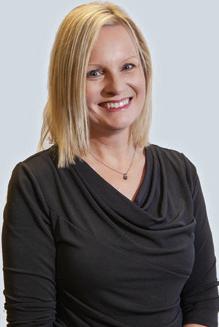


Riding is believing. www.go-metro.com

Do what you do best, we’ll take care of the rest.
For more than 100 years, we’ve helped successful business owners reach their financial goals. We’ll focus on wealth management, so you can focus on your business and enjoying life.

Let’s talk about your future today.

10 TECHNOLOGY
ELEVATE LEADERSHIP Leigh Fox has an expansive vision.
12 TALENT
HELLO, MY NAME IS... Hello Cincy happy hours bring back networking.
14 TALENT
STARTING EARLY Iranetta Wright takes over at Cincinnati Public Schools.
16
MANUFACTURING
FOCUS ON RELEVANCE Festo pushes innovation in Mason.
18 FOOD & BEVERAGE
CHOCOLATE FACTORY Aglamesis Bros brings a candy-making facility to the West End.
20 BRANDING
WHAT’S IN A NAME? Why Paycor struck a high-profile stadium-naming deal with the Bengals.
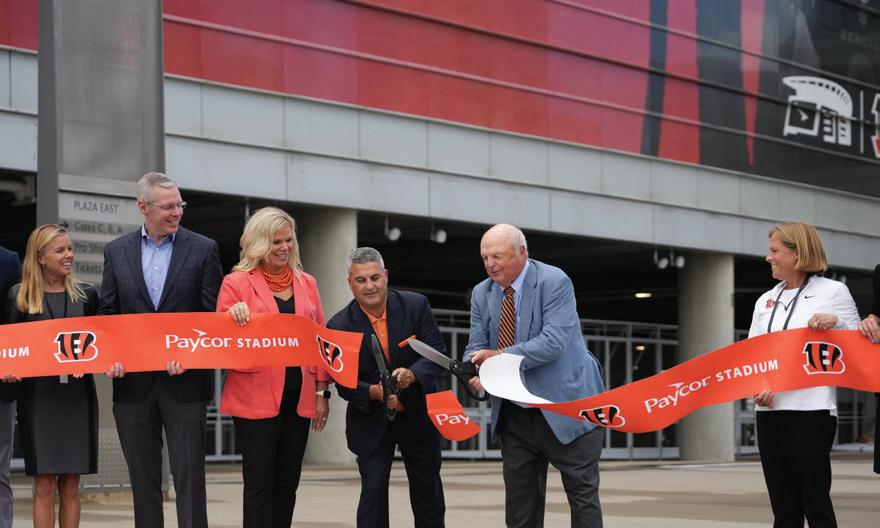
22 TECHNOLOGY
BACK TO THE FUTURE Scripps launches a national program to promote HD indoor antennas in the streaming age.

The State of the Region reports on population and job growth as well as how Cincinnati compares to nine peer cities.
A new Executive Director and veteran partners bring back Cincinnati’s largest festival.

After 30 years in Washington, D.C., he’s ready to return to the private sector.
An old business district gets new life thanks to small business owners.
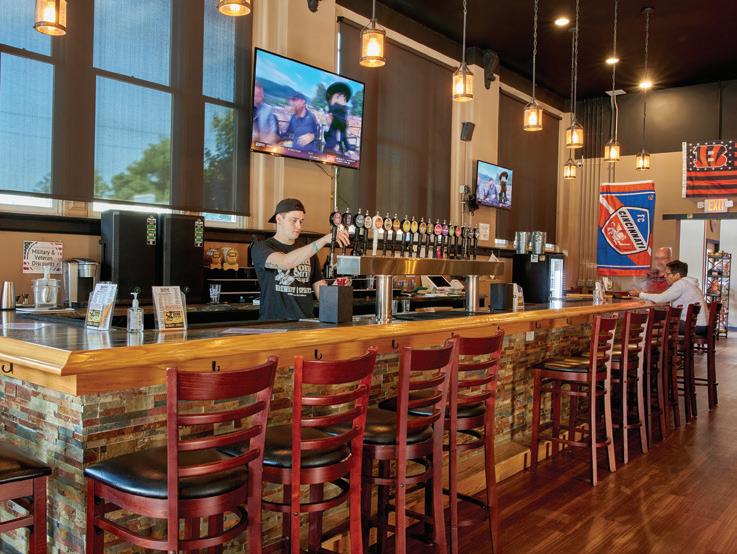
62 ASK ME ABOUT
Get to know Chara Fisher Jackson of Preschool Promise, Michael Taylor of Turfway Park Racing & Gaming, and Sara Cooperrider of Taft Law.
PG. 56
FLIPPING THE SCRIPT ON SUPPLIER DIVERSITY



How expanding a company’s supplier roster benefits everyone.
SMALL BUSINESS IS A BIG EFFORT
Why corporate leaders are supporting neighborhood business districts.
64 FROM THE DESK OF Christie Kuhns, CEO of the Urban League



ON THE COVER: PHOTOGRAPH BY ROOTED CREATIVE



(513) 579-3100
All contents © 2022 Cincinnati USA Regional Chamber. The contents cannot be reproduced in any manner, whole or in part, without written permission from the Cincinnati USA Regional Chamber.


It’s time to light up our Future City! As you read this issue of Realm, BLINK will be taking over our region, lighting up buildings, spaces, and faces throughout downtown, Over-the-Rhine, and Covington. The BLINK team, with the Cincinnati Chamber as the event’s executive producer, will inject more than $100 million into our local economy, a jolt that shows the world we’re an international destination for arts, culture, and diversity.
BLINK isn’t just an event—it’s a shared experience that nes who we are in our many unique ways. And in this issue, you’ll enjoy a behind-the-scenes look at how it all comes together.

The Future City is about more than arts and culture, of course, and you can read about all of it in these pages. Check in on how companies are continuing to make supplier diversity a priority and how vibrant storefront businesses contribute to our local economy and well-being. Go in-depth with Sen. Rob Portman, who explains how he’s looking forward to returning to the business world after 30 years in Washington, D.C.
And make sure you preview our inaugural State of the Region report on page 8. Download the full report at cininnatichamber.com/stateoftheregion, where you’ll nd a treasure trove of data to help you drive your business forward and help our region meet aggressive goals for growth.

Thanks for leading the way!
JILL P. MEYER





jill.meyer@cincinnatichamber.com












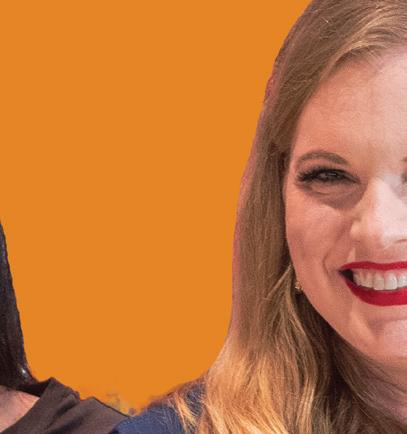



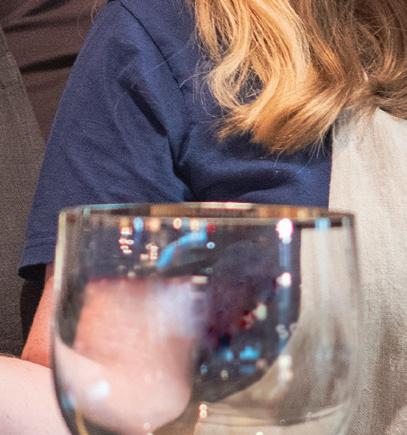




ADD ANOTHER TASK TO YOUR POST-PANDEMIC NORMAL: A RETURN TO NETWORKING.

Get a jump on news about a modern retro project from Scripps, Paycor’s stadium-naming deal, and a new Aglamesis candy factory in the West End. And get to know Leigh Fox, CEO of altafiber, and Iranetta Wright, the new leader at Cincinnati Public Schools.
The annual State of the Region report combines U.S. Census data, proprietary research, and projections to offer an economic snapshot of the 16-county Cincinnati region. Population trends show potential growth over the next few decades, but it’s not guaranteed. The U.S., and the Midwest in particular, have an aging population and decreasing immigration, which make talent attraction, connected communities, economic development, and policy advocacy more important than ever to maintain population growth, especially after 2040.
LARGEST EMPLOYERS IN THE REGION
Kroger
Cincinnati Children’s Hospital 16,742
TriHealth
University of Cincinnati
UC Health
St. Elizabeth Healthcare
Procter & Gamble
Source: Cincinnati Business Courier
1950 1.24 million
1980
2010
2020
2040
2.26
2.49
+10 to +20%
+5% to +10%
+0 to +5%
-0 to -5%
-5% to -10%
Health Care/Social Assistance 149,641
Government 128,425 Manufacturing 114,486 Retail Trade 103,381 Accommodation/Food 86,947
The Cincinnati USA Regional Chamber regularly compares this region to nine geographic peer regions on 20 key economic indicators: Columbus, Cleveland, Indianapolis, Detroit, Dayton, Louisville, Lexington, Nashville, and Pittsburgh. All are located within 500 miles, and most are similarly sized to Cincinnati.
Cincinnati ranks #4 out of the 10 regions (Average of all 20 data indicators)
Total Jobs: 868,971
Source: Lightcast
10-20%: Boone, Warren 5-10%: Butler, Clermont, Kenton
THE JUMP Statistics provided by the Cincinnati USA Regional Chamber’s Center for Research & Data. Source: U.S. Census State
Cincinnati ranks #2:
• Number of Fortune 500 companies (7)
• Lowest violent crime per 1,000 people
Cincinnati ranks #3:
• Regional real GDP ($135.5 billion)
• Lowest property crime per 1,000 people
Cincinnati ranks #4:
• Median household income ($66,435)
• Lowest child poverty rate (15.8%)
Less than 5%: Campbell, Dearborn, Franklin, Gallatin, Grant, Hamilton
Population Loss: Bracken, Brown, Ohio, Pendleton, Union
Source: U.S. Census
• Tech jobs (44,607)
8 REALM FALL 2022 REGION’S Region report


LLeigh Fox, president and CEO of altafiber, is winding down a two-year term as chair of the Cincinnati USA Regional Chamber’s board of directors, as disruptive a period as there’s ever been. His leadership is credited with helping the business community stay focused on a bold playbook for growing the region into a large, diverse, globally significant city rich with innovation, opportunity, and quality of life.
Fox’s vision for altafiber is no less bold, as he’s positioning the company’s communities to be leaders in the digital infrastructure space. He wants Cincinnati to have one of the most densely fiberized internet infrastructures in the U.S.—and also one of the most equitable. “Fiber infrastructure is incredibly important to the future of every city,” he told a Chamber member briefing in April. “It’s also incredibly important that everyone has access.”
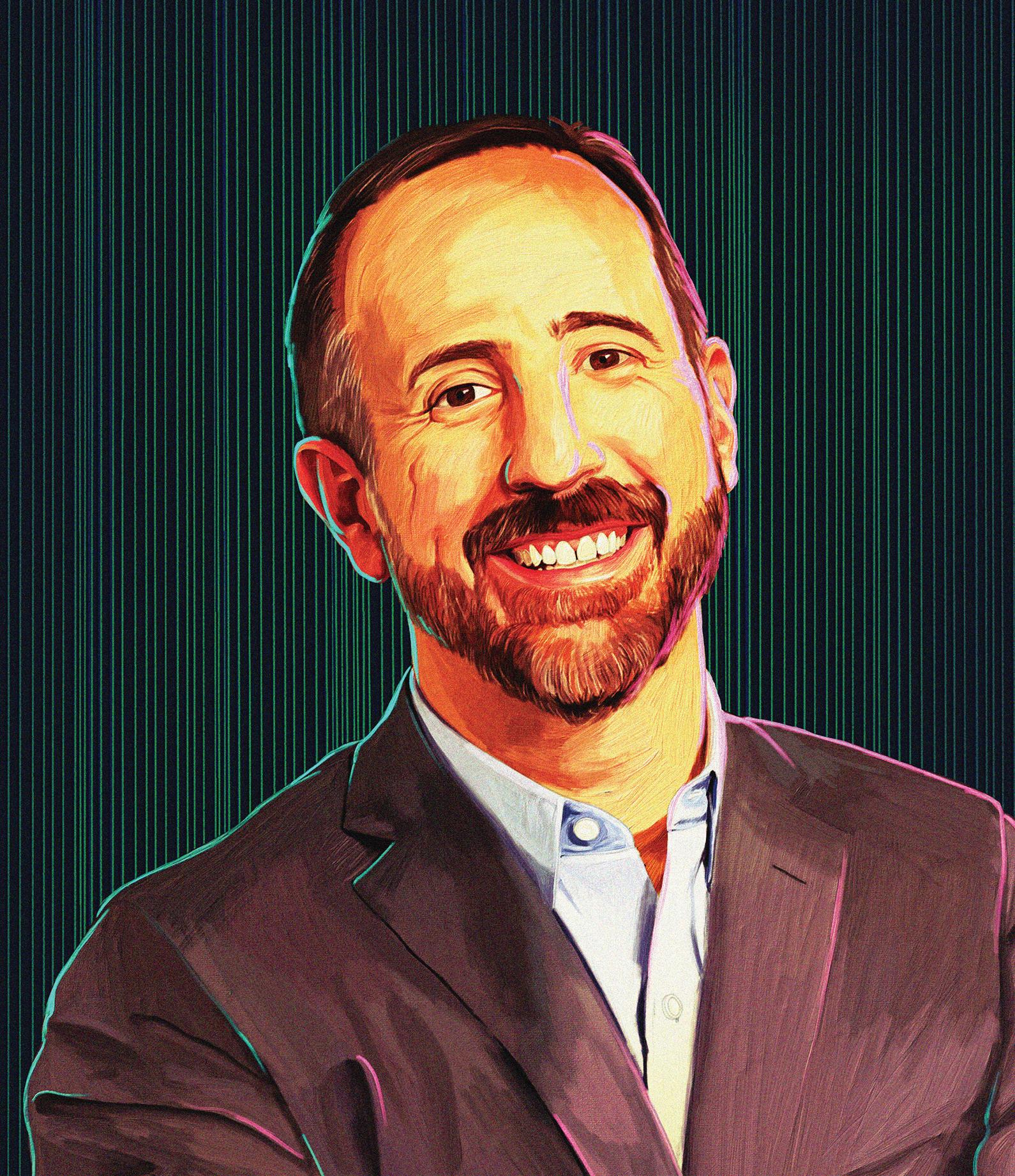
The company’s fiber installation in this region is about 60 percent complete, Fox says, and will be substantially completed by the end of 2023. Like Chamber CEO Jill Meyer, who is steering the momentum of a Cincinnati/Dayton collaboration toward a shared vision for a combined mega-region, Fox thinks outside of the company’s traditional footprint for altafiber’s growth. He grew up in Cincinnati and earned his MBA at the University of Cincinnati, but “my consideration of what this region looks like doesn’t stop at the river.”
Fox refers to altafiber as the “artist formerly known as Cincinnati Bell.” His 22-year tenure and track record of decisive leadership gives him the privilege of having some fun with the company’s new name after its 100-plus years of life as a former Bell telephone subsidiary. He likes the new name, though, because alta means elevated. “I really wanted people to start to talk about and see the word ‘fiber’ and understand why infrastructure makes a difference in their lives,” he says. “We are truly leaning into inno-
Cincinnati Bell’s 2021 acquisition by Macquarie Infrastructure Partners V in a deal valued at approximately $2.9 billion took the company private and opened up access to transformative capital. “The public markets were not giving us the access to capital needed to really invest in the future in the ways that we felt were appropriate,” says Fox. Scale matters because you can “take control of your destiny and be the ones in the driver’s seat.”
In Cincinnati, sitting in the driver’s seat means not only upgrading the digital infrastructure but also expanding affordability to it so that everyone benefits.
“It’s exciting for me personally to be able to do this work in the city I grew up in and to be able to say, once we’re done, that we’re incredibly modernized from an infrastructure standpoint,” says Fox. “There are really two issues with respect to digital equity: the access and aff ordability of the access. And so we’re working to solve both.”
“I really wanted people to understand why infrastructure makes a difference in their lives,” Fox says about the new altafiber name.

After two years of working from home and masking and social-distancing in public, people can be forgiven if they’ve forgotten how to network. Establishing connections and building your personal brand never stopped being important in the business world, just logistically hard to pull off. “Hello Cincy” is hosting a series of happy hours this year geared to helping newcomers to town, remote workers, small business owners, and others network in a relaxed environment.
The free events run 5:30–7:30 p.m. once a month at downtown’s Kinley Hotel, starting May 24 and concluding on October 11. “They’ve been attracting between 50 and 100 people each, a size that’s just right,” says Kabrella Clark, talent connections manager at the Cincinnati USA Regional Chamber. “Attendees can have deeper conversations with fewer people and not feel rushed to meet every single person.”

The events have attracted lots of first-timers and a number of repeat attendees, says Clark, and everyone from recent college graduates to executives. The June 21 happy hour included (from left) Marie Brown, Trevor (T.J.) Phillips, and Monty Taylor.
Besides the happy hours, the Chamber’s “Hello Cincy” networking efforts include the Cincy Chat speaker series, the HYPE program (Harnessing Young Professional Energy), and Cincinnati Intern Network Connection. “Workers are anxious to get out and meet people, and that isn’t changing any time soon,” Clark says.

Iranetta Wright wants to help build the next generation of teachers.
—SARAH M. MULLINSIn February, Cincinnati Public Schools (CPS) announced Iranetta Wright as the new superintendent of Ohio’s third largest school district. Before moving here, she was deputy superintendent at Detroit Public Schools, where she led principal leadership initiatives and implemented programs to improve low-performing schools.
On her first day in Cincinnati, Wright hit the ground running with a 100-day plan to “engage, explore, evaluate, and equip.” By June, she’d visited all 65 schools in the city; hosted more than 13 listening and learning sessions with parents, staff, partners, students, the community; met with each principal; and held a principal academy.

“My goal when I first arrived was really to learn everything that I could about our city and about Cincinnati Public Schools,” says Wright. “I want everyone to know that I’m accessible and visible. I value questions. I value commentary. I listen, and I want to discuss challenges. I am committed to frequently communicating with the community and ensuring
there is continuous feedback.”
Among the goals she’s passionate about, Wright says teacher development and access to college education are two areas of focus. According to a National Education Association survey, 55 percent of teachers are considering leaving the profession earlier than they originally planned. CPS acknowledges the national trend and is dedicated to nurturing the pipeline of teachers graduating from area universities, says Ben Lindy, president of the Cincinnati Board of Ed ucation. “We are focused on building strong talent pipelines for teaching positions [and] racially diverse pipelines so that more and more of our students can see themselves reflected in their teacher,” he says. “That’s also true for finding great principals, because principals set the culture for school building and great teachers want to
work in buildings with strong culture.”
Starting in sixth grade, CPS Strongoffers summer programs to prepare and expose students to the academic discipline they’re interested in. Once students are juniors and seniors, the program helps students apply to college— then helps with the application process and obtaining scholarships, financial aid, and other resources that aid in the college search process. Once a student is on campus, support continues to make sure students achieve academically and have a successful college experience.
“We’re looking to double the rate of students who are actually going into postsecondary educa tion,” says Wright. “We recognize that it’s important that there is strength in Cincinnati. We think of collective workforce development, making sure that we’re keeping the best and brightest students in Cincinnati, so that they are able to give back to the city. Our partnership with area universities and other pathways will definitely help accomplish this goal.”
“We want to double the rate of CPS students going into postsecondary education.”TALENT Iranetta Wright visits John P. Parker Elementary in March after being hired as the new CPS superintendent.

















The average consumer has likely never heard of Festo, a German-based company with U.S. headquarters in Mason, but virtually everyone feels its effects. Producing over 30,000 standard parts used in manufacturing machinery, Festo supplies pieces for systems that make our world go ’round—from cars and food to medical devices and amusement park rides. “We’re several steps removed from the consumer, so most people wouldn’t ever know us,” says Sean O’Grady, director of sales operations.
Founded in 1925, Festo has come a long way from its woodworking origins. Its North American headquarters launched on Long Island in 1972 and moved to Mason in 2015 following a national search. An expansion in 2018 tripled the building’s footprint.
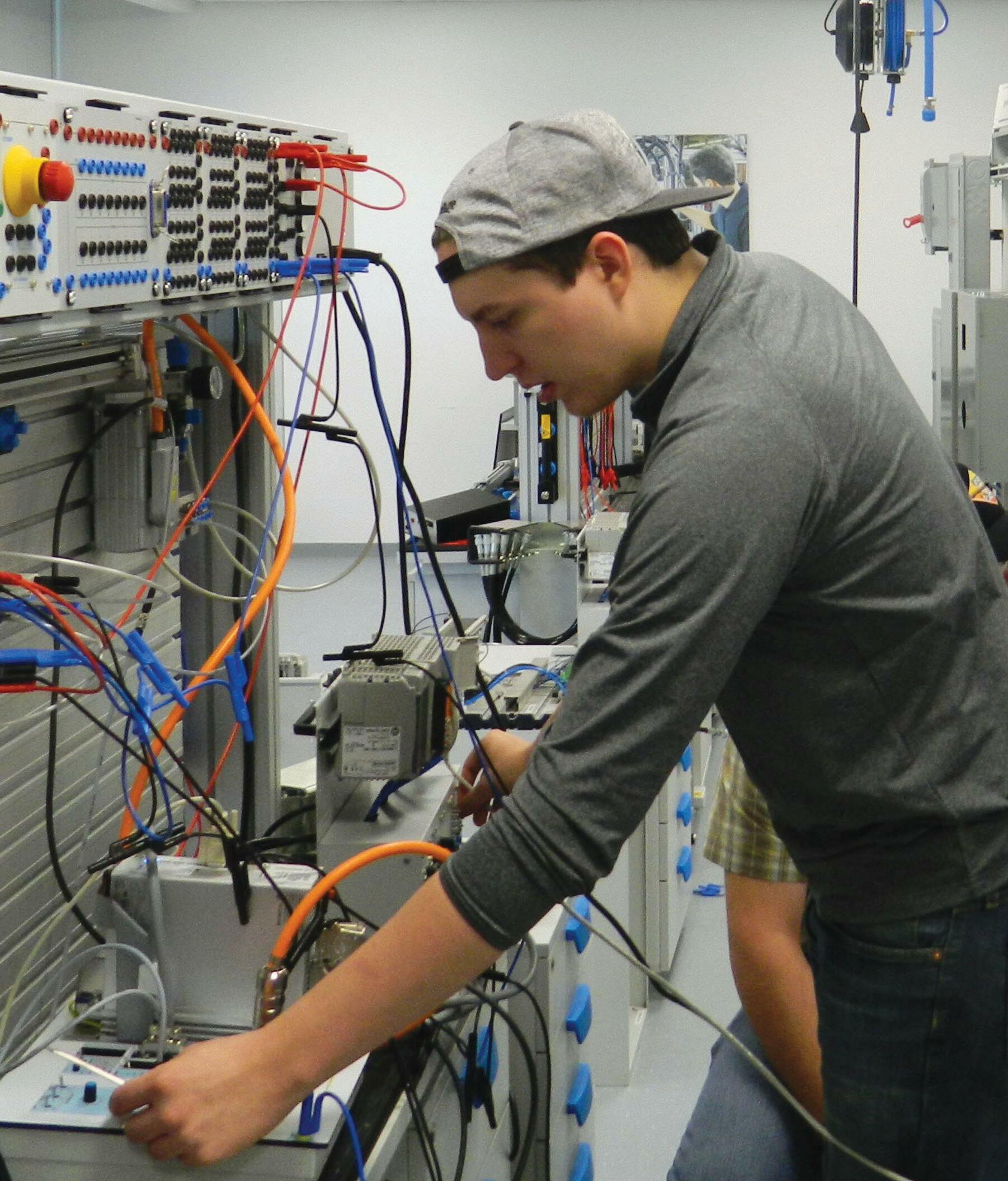
Today, with 250 employees and plenty of elbow room, the local location is a hub of innovation. Investments in high-tech automation have yielded vast capabilities in what O’Grady calls “mass customization,” which allows for product modifications to suit specific customer needs. (One particular product can be configured in 10 to the 780th ways.)
This uptick in mass customization has increased Festo’s reliance on local companies for raw materials, rather than shipping them from overseas. “All of these elements, when taken together, allow our output to rise more quickly than our costs,” says O’Grady, “but the real power is in being able to help our customers quickly solve a wider variety of manufacturing challenges.”
That said, the topic of automation tends to raise eyebrows. What happens to human jobs while automation is making the industry more efficient? Should we worry that manufacturing workers will be edged out of their livelihoods? The short answer is no, says O’Grady, who compares manufacturing’s automation evolution to that of ATMs. While it’s true that ATMs have decreased the need for bank tellers, the automation of money withdrawal enabled the banking industry as a whole to expand in scope and sophistication. “Today there are more workers in banking than ever before,” he says.
Likewise, Festo Didactic, the company’s training arm, is preparing people for jobs of the future by teaching skills that will remain relevant for decades. From twoday courses to full apprenticeship programs, Festo offers product and technology training to equip the next generation of manufacturing professionals and help them climb beyond basic machine-like tasks. Classes are vendor-neutral, meaning people aren’t pigeonholed into Festo products and are instead equipped to operate new technology on various platforms.
For this forward-thinking plan to work, however, employers, community colleges, and government agencies need to step up, says O’Grady. “Jobs that require some technical skills are going unfulfilled, and we’re chomping at the bit to deliver that capacity to folks. It’s very rewarding and also very challenging to see how much opportunity is going unmet.”
—ELIZABETH MILLER WOOD Festo apprentice Jason Lewis works with advanced industrial controls during training.
Income Solutions
Goal-Based Planning
Preservation Strategies•Stock Option Planning
Peter’s investment team provides comprehensive planning focused on achieving your unique financial objectives. It’s a process to grow your wealth in support of your life and retirement goals. Peter believes his years of experience provide a significant benefit to his clients. He partners with you to keep investment strategies aligned with everchanging goals and needs. For three decades, he has helped clients develop investment strategies that meet their objectives. Peter’s 31 years of experience as a financial advisor gives him a unique perspective on market behavior. His knowledge of and access to an expansive array of investments and platforms provides him the tools necessary to help clients succeed financially.

513-985-2871
Retirement
Investment and Insurance Products are:

•Not Insured by the FDIC or Any Federal Government Agency
•Not a Deposit or Other Obligation of, or Guaranteed by, the Bank or Any Bank Affiliate
•Subject to Investment Risks, Including Possible Loss of the Principal Amount Invested
Wells Fargo Advisors is a trade name used by Wells Fargo Clearing Services, LLC, Member SIPC, a registered brokerdealer and non-bank affiliate of Wells Fargo & Company. [CAR-1221-00154]
513-985-2170

Aglamesis keeps up with customer demand by expanding production and maintaining traditions.
—SARAH M. MULLINSFrom caramels and toffee to Italian ice and ice cream, Aglemesis Bro’s ice cream and candy shop has been an Oakley neighborhood staple for more than 100 years. The new generation of ownership is ready to expand the company footprint after planning a new chapter for years.



The business started in 1908 when Thomas and Nicholas Aglamesis moved to Cincinnati from Greece and opened their first ice cream parlor in Norwood, followed by a second location in Oakley Square clad with Tiffany light fixtures and an old-timey feel that remains today. Thomas’s son Jim took the reins eventually, opening the Montgomery store in 1970 and renovating an apartment above the Oakley store to serve as the company’s chocolate factory. Current president Randy Young, stepson of the late Jim Aglamesis, says it was time to invest in a new space. “For the last decade, we’ve been in fear of new and large clients coming to us because we just could not fulfill their orders,” he says. “We just couldn’t take on any more.”
The company purchased a 7,000-square-foot
building on Central Avenue near FC Cincinnati’s stadium before the pandemic, but original construction plans were put on hold. Work is finally scheduled to begin this fall, with hopes of opening in the winter. Young says the space will increase candy production and serve more corporate clients, especially around the holidays, with plans for a small retail storefront after the production plant is up and running. “We wanted to be close to downtown, close to business headquarters, and to stay in Cincinnati,” he says. “We’re a life-long Cincinnati company. Our products are made in Cincinnati for Cincinnati, and that’s important to us to be loyal to the city. We want to be able to grow here.”
Young says he’s also planning a rejuvenation of the timeless Oakley store in addition to the new production facility—keeping the
original details but updating for the first time in 50 years without compromising what makes the location special.


Young says that despite the company’s rapid growth, larger production space, and update of the landmark Oakley shop, the process of making Aglamesis Bro’s products isn’t changing. Their oldschool approach to chocolate-making remains, including using copper kettles and wooden paddles. Maintaining the business as is, Young says, keeps customers returning for gifts and the in-store experience.
“We’re not fully automated, and we do a lot of work by hand,” he says. “The only thing we are changing is the amount of space we’re using and where we’re going to be doing it. We want our product to be made by hand—boxes are still packed by hand and many chocolates are dipped by hand. That’s just who we are.”
“Our products are made in Cincinnati for Cincinnati, so we’re loyal to the city.”

As we celebrate the return of BLINK, we are reminded that innovation and creativity are essential to disrupting the status quo. Meaningful change happens when we refuse to be bound by tradition.
Recognizing that law firms were not evolving to keep pace with clients’ needs, we sought to transform service delivery. Our focus on innovation led us to develop SmartPaTHTM, a comprehensive program for managing and delivering legal services that enables us to deliver creative, customized solutions while providing maximum value.
We invite you to learn how our innovative approach to service aligns with your business goals.
Our commitment to innovation is embodied in SmartPaTH™ – a smarter way to work –predictable, efficient and aligned with client goals.
ThompsonHine.com

 —SARAH M. MULLINS
—SARAH M. MULLINS
Human capital management company Paycor inked a multi-year stadium deal with the Cincinnati Bengals after a historic football season and Paycor’s IPO in 2021. Paycor has been headquartered here for more than 30 years, serving mostly regional clients with human resource and workforce management software solutions. Under CEO Raul Villar Jr., growth goals include becoming a nationally recognized and utilized company—and the Bengals deal provides that kind of visibility.
Paycor has been the Bengals’ official and exclusive human resources software provider since 2018, and the naming rights deal made sense for both sides. Aligned on mission and values, the two businesses empower organizations to build winning teams and maintain healthy competition—putting high-performing teams with the right players on the field. Paycor’s local roots inspired the idea to expand its partnership to include exclusive naming rights to the stadium, a 16-year deal that renames Paul Brown Stadium to Paycor Stadium. “If you think about the Bengals story and Paycor story, they’re similar,” says Paaras Parker (pictured), chief people officer at Paycor. “We’re both locally founded and over the last few years have expanded with a hometown following and expanded outside the regional area. Both have the culture of engagement and ties to empowering teams and empowering leaders.”
New Paycor signs on the sta-
dium mean brand recognition nationwide, not only for partnership opportunities but for recruiting purposes, says Parker. She notes that Google searches and job inquiries have dramatically increased since the announcement of the stadium’s new name. Although Paycor’s headquarters is in Cincinnati, it’s now a remote-first company with employees spread through out the country. The stadium name increases visibility and helps recruitment on a national level, especially in a time when remote work opportunities offer a competitive advantage to secure the best talent.
“Given the power and viewership of the NFL, we can now showcase the Paycor brand on a national scale like never before,” says Parker. “It’s a beneficial and strategic part
nership for our organizations and also for the community that we work and live in.” She says that, when prospective employees know a company’s brand and mission, it can be easier for recruiters to attract talent.
Beyond recruiting, Paycor plans to celebrate existing employees through the partnership. Employees will be rewarded with incentives such as seats at Bengals games and other exclusive opportunities. For example, a group of 100 Paycor employees attended a Bengals preseason scrimmage with the Los Angeles Rams at the team’s practice facility. “Our employees are the heartbeat of our organization, helping lead to our public offering last summer and now leading us to the naming rights deal with the Bengals,” says Parker. “We are so excited to give them something to be proud of in our community, while improving things for our customers and business partners.”
 PHOTOGRAPHS BY (TOP) ROSS VAN PELT / (BOTTOM) CINCINNATI
PHOTOGRAPHS BY (TOP) ROSS VAN PELT / (BOTTOM) CINCINNATI
Being a member of the Cincinnati USA Regional Chamber gives you access to valuable Cost Saving Programs designed to help your business thrive even in seasons of unfamiliarity. As your business changes and adapts with the times, we recognize the need our members have for this network of resources now more than ever.

HEALTH INSURANCE
ChamberHealth™ can save you up to 20% on health benefits with and Humana™ and Go365™ health & wellness program
Momentum Investors & Gold Members receive 4 round-trip tickets at a 50% discount with Ultimate Air Shuttle
ChamberComp™ saves you up to 53% on Group Rating, 62% or more on Group Retrospective Rating through Sheakley
With 6,000 clients and more than $170M in tax-free dollars to business owners, see how much you may qualify for this congressional mandated program through Business Group Resources. Sign up for a Free Analysis
Save up to 55% off nearly every item in stock at Office Depot/Office Max
Save up to 40% on your credit card and debit card payment processing wit i3 Merchant Solutions
Impact business growth and enhance future value of your business with IdeaTeam
cincinnatichamber.com/save Customizable cyber security educational sessions from Oswald SAFETY COUNCIL The Greater Cincinnati Safety Council is one of the largest Safety Councils in the region. It is comprised of local companies –independent of industry – dedicated to the safety of their employees
ENERGY Take control of energy costs with Good Energy
TELECOM & IT SERVICES
Save up to 35% on voice, network, cloud and cybersecurity services with Advanced Technology Consulting

Rabbit ear TV antennas harken back to a time when you and your family watched game shows or the evening news together, adjusting that pesky “technology” whenever things got a little static-y. So it’s probably the last thing your HD smart streaming TV needs now to connect with your favorite shows, right? Actually, the indoor antenna is making a comeback, says Amanda Brown, vice president of consumer strategy and insights at E.W. Scripps Co. “It’s retro but becoming modern,” she says of the company’s Free TV Project.
Scripps launched Free TV to explain how a simple piece of updated technology can allow free access to more than 30 channels, including HD and live sports, local and national news, comedies, special events, essential local weather updates, and family programming. Brown says she has access to 57 channels through her antenna at her Anderson Township home; typing in area Zip codes on the Free TV website shows that Covington residents might have 49 channels and Lebanon residents 67.
The unwelcomed static of past years is long gone, Brown says, and you can expect significant changes since the last time you used an antenna. “The broadcast technology that allows you to receive the channel has made vast improvements since I was a kid,” she says. A new broadcast technology called ATSC 3.0 is making its way across the U.S. as well, with even better HD broadcast signals. More than 40 million U.S. households (one in three) currently have an antenna, according to the Consumer Technology Association, and more than 50 million are expected to have one by 2025.
Scripps, which owns 61 television stations nationwide and networks like Court TV and Newsy, isn’t necessarily asking consumers to delete all of their streaming apps for an antenna. Instead, Brown recommends “self-bundling” for many people. “They’re mixing and matching their media, mostly on the TV side, so it’s a combination of people who have cable and free over-the-air TV, plus streaming,” she says, adding that most Free TV Project users so far combine methods. The antenna will help eliminate paid channels they you get for free.
They can also add an antenna to supplemental televisions in additional rooms, says Brown. A consumer might like to watch the evening news in the kitchen while he or she cooks, for example, but doesn’t want to pay for an extra streaming setup or cable link there.
One of the last remaining drawbacks for consumers hoping to cut cable is their access to professional sports events. If you want to see the Bengals dominate each week this season, you’re likely in luck with over-the-air TV. But for those wanting to watch other national sports coverage, you might be stuck with cable or a streaming service for a while longer. “The access to sports has become more complicated,” Brown says, pointing to rights negotiations with sports organizations. “But a general consumer who wants access to fall sports on networks like NBC and CBS can get them with a digital antenna.”

Scripps launches a national program to promote HD indoor antennas in the age of streaming.




























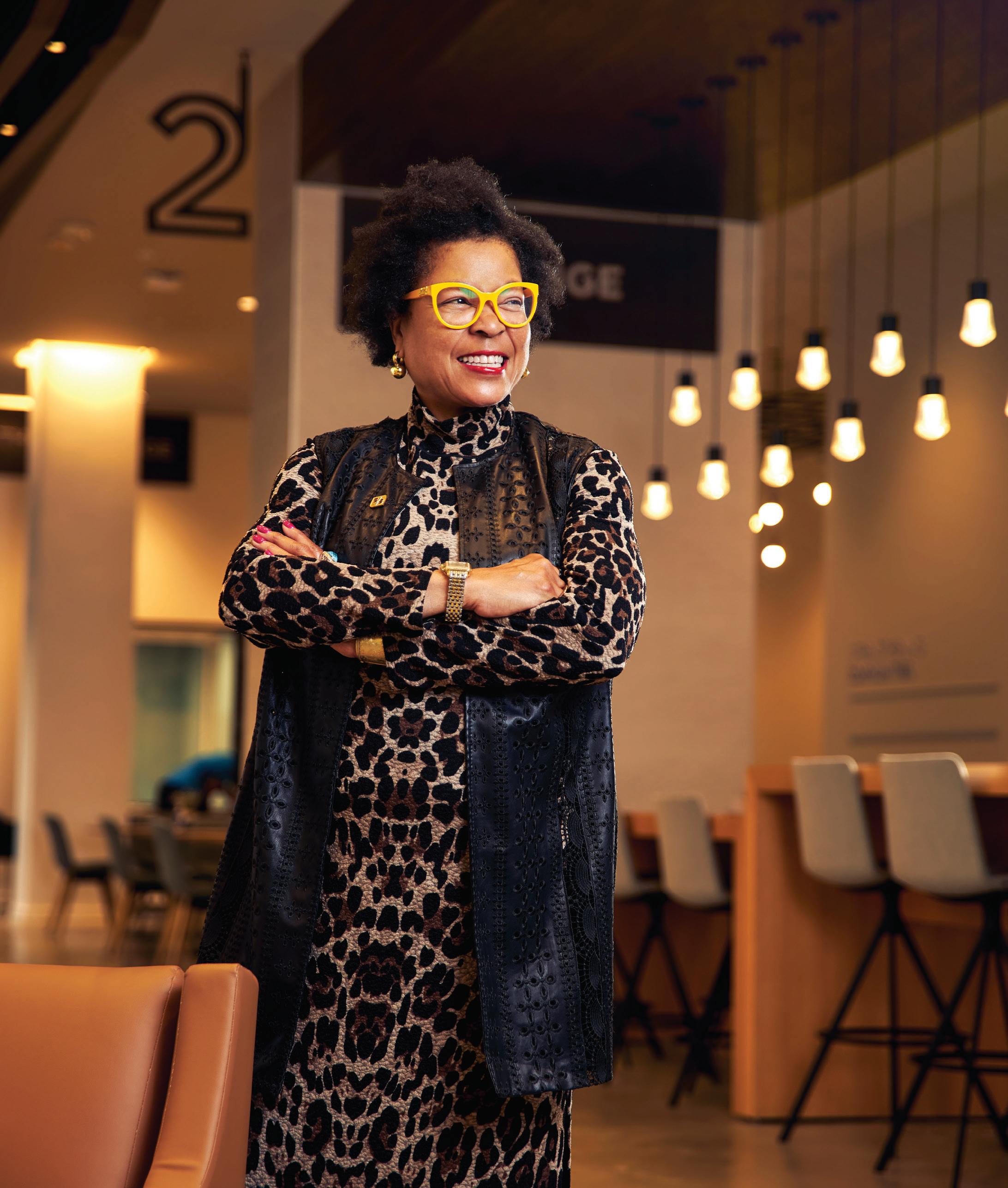


HOW NEW LEADERSHIP AND VETERAN ARTISTIC AND FUNDING PARTNERS ARE BRINGING BACK CINCINNATI’S RENOWNED LIGHT SHOW THIS FALL.
Justin Brookhart (at the podium) has assembled a strong team of experienced event partners.
The heralded lightand art-focused BLINK weekend returns for its third staging October 13–16 after a pandemic-induced delay, and those in charge say they’ve learned a thing or two over the course of its breakout 2017 and 2019 versions. The third time, as the saying goes, might be the charm.
At the helm is Justin Brookhart, who takes the reins of BLINK as its first-ever executive director. Brought on board by the Cincinnati USA Regional Chamber at the beginning of this year, he’s worked closely with
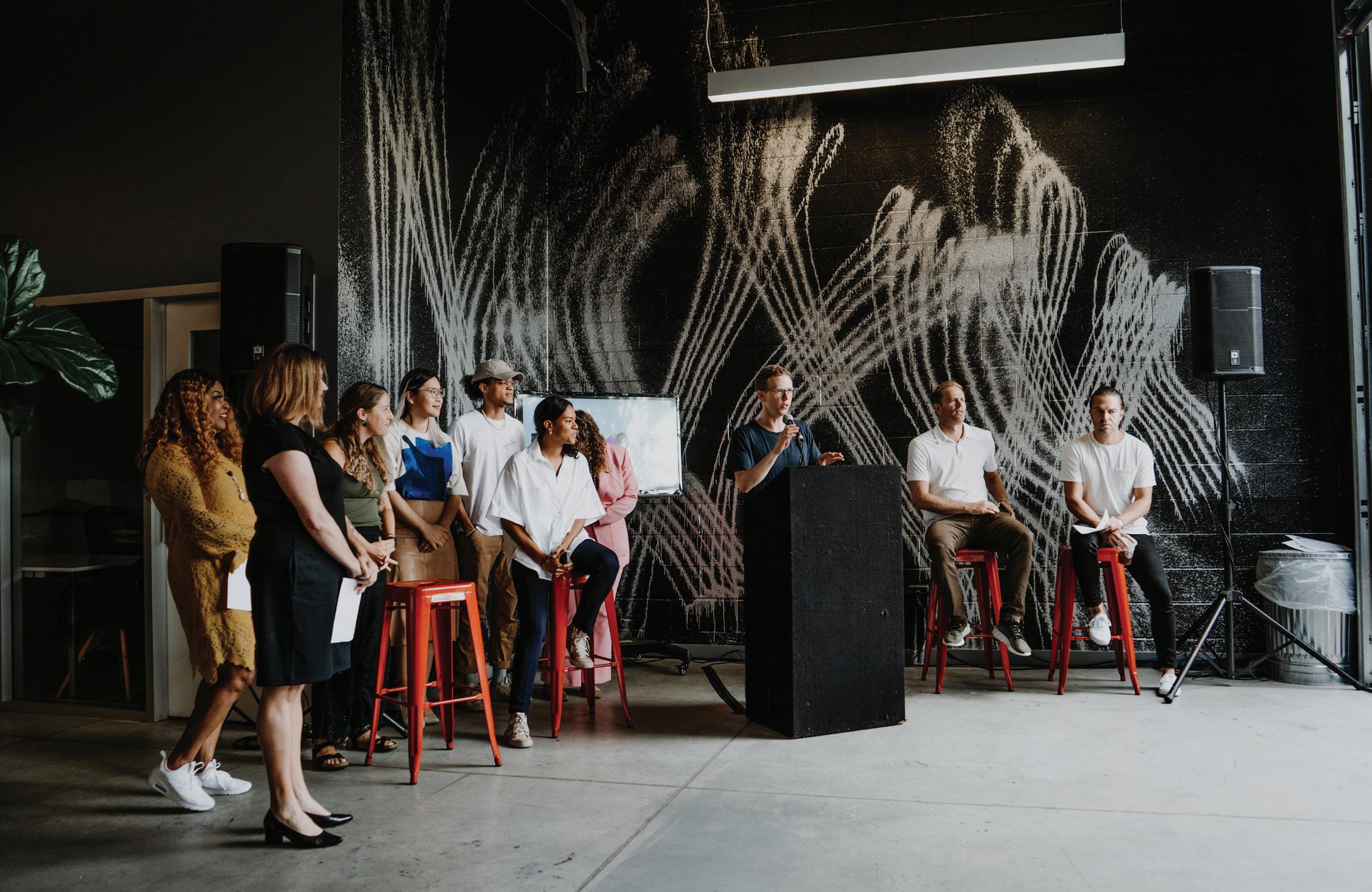
festival partners AGAR, ArtWorks, the Carol Ann and Ralph V. Haile Jr. Foundation, and Cincy Nice to make this year’s event an even bigger spectacle than before. And when the only thing you’re measured by is your own uncontested past success, the sky’s the limit. “Figuring out how to evolve without messing up that secret sauce is the key to this year and future iterations,” says Brookhart.
He’s well-versed there. A film school graduate with a master’s degree in public affairs, Brookhart helped scale up Mondo, a movie and pop-culture retail brand founded in Austin, Texas, in the early 2000s, from a tiny gallery in the Alamo
Drafthouse to a multi-million dollar organization, serving as managing director and vice president of operations by 2017. The company launched MondoCon, its own convention for fans that curated opportunities for conversation and connection.
“What informs my work here at BLINK is really thinking about how you take a weird, creative idea and operationalize it and grow it over time,” says Brookhart. “BLINK isn’t possible because of me or any of the other partners who help produce this thing—it’s possible because we help bring incredible talent to town and empower local artists, and then set them up to succeed. That’s a huge
emphasis for me.”
BLINK will once again feature new murals, projection mapping, and light installations, but in the spirit of being more artist-forward, organizers put out an international call to artists. In the past, BLINK did a combination of soliciting calls for artists in certain disciplines and direct curation for others.
“What we did this year is we asked ourselves, What if we opened up all the disciplines and said anyone who wants to join in the collaboration raise their hand, locally and internationally,” says Brookhart. “That was a big experiment. We were curious what that was going to do to the blended mix of local versus national versus international and how that evolves.”
The call to artists was on a fairly condensed timeline, but it was nonetheless illuminating, no pun intended. “What we learned is there’s just a ton of talent here locally in the Cincinnati region who haven’t felt like they had an opportunity to join the collaboration,” says Brookhart. “And we’ve opened up opportunities to those folks, which is really exciting. We’ve also seen the reach of this event. BLINK has made a global impression, which folks here might not know about.”
WENDY YU IS AN Australia-born inter disciplinary artist who works at the intersection of dance and urban media art, which she’ll showcase during BLINK at the Federal Reserve Building at Fourth and Main streets. She recently completed a research proposal for her thesis dissertation on the position of breakdancers in urban me-
dia art. One of her best known works is a partnership with Adidas to launch its Harden Vol. 6 sneakers, which culminated in a projection outside of the Barclays Center in Brooklyn.
“The attention that BLINK has for artists is really, really inspiring,” Yu says via Zoom from Australia. “BLINK curates such different art ists from different backgrounds and respects them. What’s really interesting about projection art is that people have such diverse backgrounds before they come into it.”
Yu is working with Elementz, the OTR-based hip-hop cultural arts center, to shine BLINK’s liter al spotlight on breakdancing, which in 2024 will enter the Olympic pantheon as a com petitive sport. “Breakdance and street dancers have such a history of being appropriated practices in street culture and spatial cultures,” she says. “They’ve had to always create space for themselves, and so when we’re now using urban media technolo gies—for example, high-lumen projectors or urban screens—to showcase breakdance, we’re elevating these local athletes and bringing a higher visibility to practitioners in Cincinnati. It’s fun to just track that progression of breakdance from being a form of dance with a lot of negative stigma into such a glorified and accepted artform or even sport.”
Creating an international collaboration is no small feat, especially when the choreographer can’t be in person with the dancers to set the piece. Yu uses what she calls “soft choreography,” a suggestion of movements, and allows the Elementz dancers to do what they do and know best, capturing it on camera to then fine-tune the final projected product. BLINK
audiences will see a looped projection of individual dance segments.
“The dancers just have a few boundaries within which the move ment can exist,” says Yu. “The rules are basically just staying in frame, maybe giving them a depth calcula tor to see where their body cuts out of frame. With those parameters in place, I want to be representing the dancers’ individual skills, so I’m not going to be choreographing the dance. I’m very happy for them to bring in their own improvisation or something that makes them feel represented on an urban media landscape.”
Yu has a BFA degree in dance and a master’s degree from the University of Sydney in Interaction Design and Electronic Arts. Her foray into projection art began when she was a student, making interactive designs on her computer. The screen was small, so a friend suggested she hook it up to a projector. Her projection work has taken her across the world, including now to Cincinnati audiences.
“One of my mentors said, People are attracted to projection art because it’s quite Promethean, like the fire that gathers early mankind around at night to tell stories,” she says. “It was always my intention when designing projec-
“WE’VE OPENED UP OPPORTUNITIES TO LOCAL ARTISTS, AND WE’VE SEEN HOW BLINK HAS MADE A GLOBAL IMPRESSION,” SAYS JUSTIN BROOKHART.
tion for it to stimulate people to gather around to tell stories. With breakdance, especially street dance cultures, it just seems to have and hold a really vibrant history for storytelling.”
MORE THAN 300 ARTists submitted to BLINK’s call for artists, and two waves were announced by the end of August. Several artists are making a return appearance, including Mallory Feltz, who has the distinction of participating in all three iterations—a veritable BLINK hat trick.
ing an installation of glowing umbrellas arranged in a canopy over Michael Bany Alley in Over-the-Rhine, next to the Hanke Building and Japp’s. “They were very simple umbrellas that were just highlighted with lights, but then they were set on motion sensors and so they moved and interacted with you,” says Feltz. “I know a lot of people who are coming to see BLINK don’t have a background in art, and you don’t need one to enjoy what’s going on. I think it’s really important and fun to remember this artwork is for everyone to experience and to have a different relationship with what they’re seeing.”
like choral risers, and are powered by foot pedals that come out from each lamp that guests can step on and turn on the lights.”
“When BLINK came about, it was an opportunity to make work that was going to be seen by a lot of people and experienced by a lot of people,” she says. “I wanted to share the joy of creativity and the joy of art with other people. With my BLINK pieces, there’s always a little bit of a surprise element, whether it’s how you interact with the piece or something you may not initially notice.”
“Easy Breezy,” her contribution to BLINK in 2017, was one of the most talked about on social media, featur-
Feltz earned her BFA in Sculpture from DAAP at the University of Cincinnati and her MFA in Sculpture from Louisiana State University. She incorporates themes of domesticity and home life in her works, using commonly found materials and items as an “approach point” for viewers to be able to relate to them. Case in point is her 2019 BLINK contribution, “Toy Box,” which featured seven different giant nightlights based on tra ditional toy icons. When people walked by, the nightlights were activated via motion sensors and gave off different-colored glows. She observed how folks interacted with the display but was slightly disappointed that the motion activation wasn’t more directly controlled by the individual. This year, the control is in the viewers’ hands. Or rather feet.
“A lot of guests want a direct interaction with the work and want to feel part of it,” says Feltz. “So this year my piece called ‘Linger’ is a series of lamps with words and phrases written in glow-in-the-dark paint on the lampshades. They’re installed on risers,
“Linger” will be installed in Imagination Alley on Vine Street between 13th and 14th streets. To accommodate all potential types of weather, Feltz says she engineered her design to include outdoor waterproof lamps and is building the risers herself to house the electronics inside waterproof surfaces. The foot pedals are also waterproof and shockproof, and she tested several different paints for brightness and length of electric charge. The paint itself holds illumination because it contains phosphorescent powder, itself contained within a gel medium that glows when it absorbs light.
“I was thinking about being in our homes all the time during COVID and living within that space, and then thinking of living within your body as a space and how I have trouble sleeping because it’s hard for me to shut off my brain sometimes,” says Feltz. “This work pays homage to all of the interruptive, sometimes funny, sometimes introspective words and phrases that just pop into your brain. I always hope that people take away the idea that creativity doesn’t have to be complicated but can be approachable. Art is for everyone, and there are plenty of surprises in our daily lives.”
ANEW ARTIST TO BLINK this year is Cincinnati-based Michael Coppage, although you may already be somewhat familiar with his work if you’ve ever wandered down Gano Alley next to downtown’s 21C Museum Hotel. The alley is lined in murals from his
“ONCE I COMBINED MY EXPERIENCE WITH MENTAL HEALTH INTO MY ART PRACTICE, IT FUNDAMENTALLY CHANGED THE WORK’S FOCUS,” SAYS MICHAEL COPPAGE.
“Black Box” series, featuring black and white images of Black men. During BLINK, Coppage is installing a 54foot temporary vinyl mural just across the street on the facade of the Aronoff Center for the Arts, working with Cincinnati designer Jason Snell for light projection and animation.
“From 2020 on, I would say we all have gone through a collective trauma in many ways, from active shooters to COVID to George Floyd to abortion rights,” says Coppage. “I just thought about doing something that worked against that and provided some joy in the midst of all that. I essentially proposed a Care Bear, which is a big guy sharing positive messages and affirmations and shooting the crowd with love and light. I’m hoping to build something visually interesting that creates a sense of awe and wonder.”
Coppage has storyboarded the mural animation to take viewers through the four seasons, starting with spring. He incorporates plenty of well-known Cincinnati icons, like the state bird (cardinal) and the state flower (carnation), plus nostalgia and pop culture elements as well. The mural itself is a photograph of John Willis, an actor and mental health/ behavioral health specialist at Cin cinnati Children’s Hospital Medical Center. “I wanted it to be someone I look up to,” says Coppage, who also serves as an operational supervisor at the Talbert House. “When you see John that big and you look up to him, it’s because I already look up to him. I think he’s a great representative for carrying that message of caring and joy and love.”
Willis was also involved in Coppage’s “Black Box” installation, in which the artist offered 13 photo graphs of men as entry points for frank discussions about race and
society. The project reached more than a million people with repeat in stallations in 17 different countries, six states, and Puerto Rico. “Once I combined my experience with mental health into my art practice, it fundamentally changed the focus of the work I was doing,” says Coppage. “To be able to take something I really
too. “I didn’t know anyone who had participated in BLINK, though I used to go every year and was blown away by how beautiful everything was,” he says. “I put BLINK on my bucket list, hoping I could one day create for other people the feeling I was experiencing myself attending the event. I finally get the chance to do that, and
believe in and include it in BLINK reaffirms for me that, one, I’m making the kind of work I should be making and, two, there are other people who are willing to offer their platforms to share this work because they believe in that mission as well.”
Coppage says BLINK’s inclusion of local artists and socially relevant themes is a win for Cincinnati be cause when people see that his work is featured in a prominent location, it’s almost like their work is included,
it’s just really serendipitous. I’m really looking forward to seeing how people respond to it.”
MURALS HAVE BEEN A cornerstone of BLINK from the very beginning, both in their own right and as can vases for imaginative projection animation and light mapping. AGAR,

One of the joys of BLINK is discovering unique, out-of-the-way experiences and sharing them with others.
THIRD TIME IS THE CHARM BLINK returns to downtown Cincinnati, Over-the-Rhine, and Covington after skipping last year due to the pandemic. The first two versions, in 2017 and 2019, attracted the largest public crowds the region had ever seen. This year’s programming will happen across an expanded footprint stretching more than 30 city blocks. All events are free.
Justin Brookhart, hired from Austin, Texas, as BLINK’s first-ever executive director, put out an international call to artists to participate in this year’s event, while simultaneously opening more opportunities for local artists. The result is BLINK’s most diverse talent roster ever.
THE POWER OF ART
Andrew Salzbrun of longtime BLINK collaborator AGAR hopes Cincinnati can witness, as other cities have, international public art’s ability to “transform neighborhoods by economically impacting them through tourism, hospitality, residential development, and a sense of placemaking.”
one of BLINK’s producing partners, has been inspired over the years by the Wynwood neighborhood in Miami, Florida, where the Wynwood Walls function as an outdoor street art museum, with graffiti and mural art from such industry greats as Shepard Fairey. Previously involved in LumenoCity, the precursor event to BLINK, AGAR is stepping up to again combine lights, projection mapping, and mural art for the 2022 weekend.
“We all kind of looked at each other and said we wanted to do something different and bigger,” says Andrew Salzbrun, AGAR’s managing partner. “AGAR had been doing a lot of work in Wynwood in Miami and saw just the power of densely populated international public art and how it transformed neighborhoods by economically impacting them through tourism, hospitality, residential development, and a sense of placemaking.”
The AGAR team brought that inspiration back to Cincinnati, sharing it with the Findlay Market board and Tim Maloney of the Haile Foundation, a primary backer over the years of both BLINK and LumenoCity. Using their connections and their industry insight, AGAR took on the mural mantle, importing world-renowned artists to transform the walls around Findlay Market. That same ethos is the standard to this day.
“We aren’t prescriptive in the artwork that our artists bring to BLINK,” says Salzbrun. “We asked them not to be laced with profanity or big political messages and that they can be kid- and family-safe, but otherwise we don’t give them a theme, direction, or colors to stick within. It allows us to showcase world-class artists in a blank-canvas situation and expose that to a large amount of people all at once. We’ve gone out of our way to spend a signifi-
cant amount of time recruiting the best artists in the world to come here and be a part of our portfolio.”
There are 17 murals going up during this year’s BLINK event. Two were selected through the call-to-artists process, and others are from artists AGAR has been attempting to bring to BLINK for several years. In total, including this year’s new additions, there are about 45 murals across the urban core that have been installed for BLINK. Practicality restricts projection-mapping all of them.
“We typically choose five to six that either have a great story or would lend themselves well to projection mapping,” says Salzbrun. “Some of the muralists will come in with a projection mapping artist in tandem.”
In 2019, a mural by artist Faith 47 at the corner of Vine and Liber ty, depicting a woman riding a horse with a flag (thematically based on Eirene, the Greek goddess of peace), was projection mapped by South African artist Inka Kendzia. The result proved so popular and so compelling that AGAR is bringing Kendzia back this year to do another show on that same mural.
“One of the biggest ‘gets’ for us this year is Insane 51 out of Greece,” says Salzbrun. “He’s a muralist who paints in a technique where the viewer wears 3D glasses. It’s so cool. He basically paints the same image three times: One is the subject’s flesh layer, one is the skeletal layer, and the third is the combined image between the two, so when you wear 3D glasses you can just experience this mural in an incredibly interactive way.”
Other muralists this year include Tristan Eaton, one of the biggest street artists in the world right now; PichiAvo, a duo of street artists from Valencia, Spain; CASE Maclaim from
“The whole point of BLINK is you’re on the streets and you’re with the community as a whole in a shared experience,” says Executive Director Justin Brookhart.

Germany; Cincinnati-based Chris Gliebe, who uses the street moniker “The Devious;” and the anonymous art collective Mz.Icar. AGAR is also helping lead the weekend’s musical component this year, with several acts set to perform on stages within the BLINK footprint, including at Washington Park and Fountain Square.
THERE ARE FIVE DESignated BLINK Zones: Over-the-Rhine, Findlay Market, the Central Business District, The Banks, and Covington. It can be overwhelming to navigate all five ar-
eas, and if attendees need a bit of a respite in the midst of BLINK revelry, CincyNice is ready to answer the call. The collective, led by siblings Destinee Thomas and Billy Thomas, formed during BLINK 2019 as an opportunity to carve out space within the event footprint for artists, musicians, and other creative individuals to connect with each other and with visitors.
CincyNice established a home base at Switch Lighting, a storefront on Fourth Street, to create a social house filled with art, lighting, and couches. They saw more than 1,000 people during the 2019 event, in cluding visiting BLINK artists, and realized the special opportunity they had to offer a connection point during
an event that attracted more than 1 million visitors.
“We’re very excited to bring back the CincyNice Social House,” says Billy Thomas. “It’s a space of wel comeness where people can connect, and we’re looking to work with a lot of diverse local and national creatives to bring the space to life. We want people across the city generally to feel like BLINK is theirs as well.”
This year’s Social House will be located in the former People’s Liberty space in the Globe Building across from Findlay Market. The team will host several nights of programming featuring musicians and storytelling. “There’s something really special about the feeling of You’re welcome that Black people in particular do, and there’s something really special about welcoming you into a home,” says Destinee Thomas. “I want people to feel that warmth and that moment to be themselves within the city, and I hope they’ll keep coming back for more of their most authentic self and keep creating that beyond BLINK.”
In the end, that’s really what this four-day experience boils down to: creating connection to both one self and to one’s community. “The whole point of BLINK is you’re on the streets, you’re in our public parks, you’re in those places and you’re with the community as a whole in a shared experience,” says Brookhart. “It’s those stories I hear about, like, Oh, I was out at a park and I saw a public marriage proposal, or I was looking at this thing and I got really emotional, and I looked next to me and a stranger was also getting really emotional, or My kid loved this thing and he was playing with a bunch of other kids. It’s that shared experience that people take away more than anything. Making sure that feels celebrated is really important to us.”

After a career in public service of more than 30 years, Ohio Sen. Rob Portman announced in early 2021 that he wouldn’t run for a third term in the Senate this year and will retire. In addition to his 12 years in the Senate, the Republican also represented Cincinnati in the U.S. House of Representatives and served in the White House under two presidents.
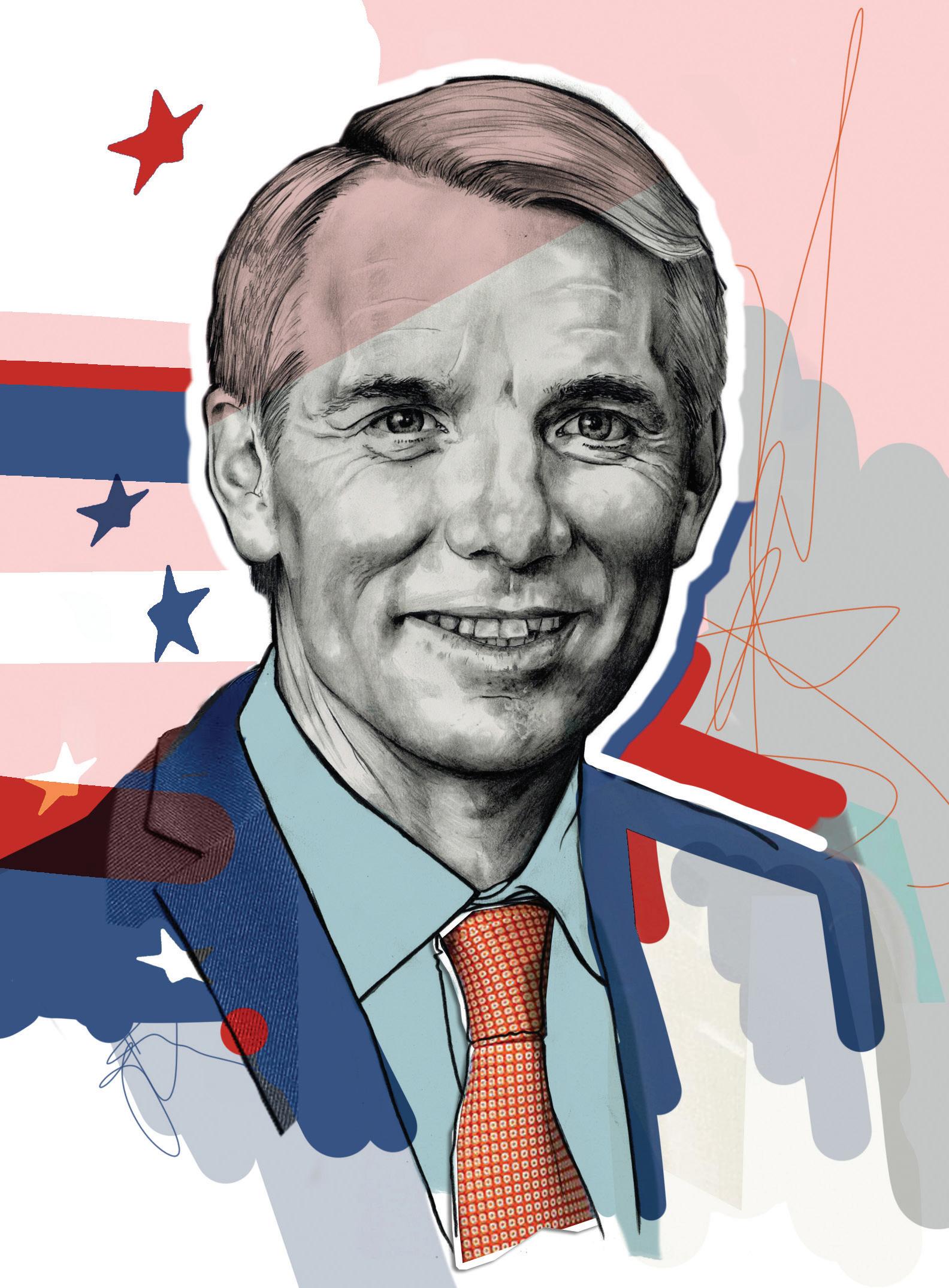
He began his career in government in 1989 as an associate White House counsel under President George H.W. Bush, for whom he’d campaigned. In 2005, President George W. Bush nominated him for the post of U.S. trade representative, where he served until 2006, when Bush nominated him to be director of the Office of Management and Budget, a huge federal agency that produces the president’s budget and oversees the performance of other federal agencies. The Senate unanimously confirmed his nomination.
In 2010, Portman ran for and won a U.S. Senate seat after George Voinovich announced he wouldn’t run for re-election. He was re-elected in 2016, beating former Ohio Gov. Ted Strickland.
Over those years, Portman amassed a
substantial legislative record and built a reputation for bipartisanship. He’s a fiscal conservative whose respectful and gentlemanly demeanor allowed him to work with Democratic senators such as his Ohio colleague Sherrod Brown and others to craft bills that would get enough votes from both parties to be enacted into law.
In a letter announcing his planned retirement from public office, Portman wrote, “I am really looking forward to being home in Ohio full time, seeing family and friends more, and getting back to the private sector, including being able to be more involved in the community and in our family business. And I plan to stay involved in public policy issues.” He also wrote of the political environment in Washington: “Honestly, it has gotten harder and harder to break through the partisan gridlock and make prog ress on substantive policy, and that has contributed to my decision. This is a tough time to be in public service.”
We spoke to him in a wide-ranging interview just after he returned from an official trip to Ukraine that he made with Sen. Amy Klobuchar, a Democrat from Minnesota. That followed a downtown reception at which the Cincinnati USA Regional Chamber honored him with the first Rob Portman Public Service Leadership Award, which the organization will present to a deserving local business leader. We discussed his career, its beginnings, politics today, and what’s next after his decades in Washington, D.C.
YOU’VE HAD A LONG AND PRODUCTIVE LEGISLATIVE CAREER, BUT ARE THERE TWO OR THREE
I approach the job a little differently than some. I believe my responsibility is that I’ve been hired to get things done, and to get things done in Washington you have to be willing to work across the aisle. You need 60 votes in the Senate, so you have to find colleagues on the other side of the aisle and you have to work together.
I think we either authored or co-authored 187 bills in the Senate that became law. I hate to pick fa vorites, but I’ll mention three. One is the infrastructure legislation because it’s so significant to Cincinnati and because it’s so recent. It will be the largest investment in our country’s infrastructure since President Eisen hower’s interstate highway system. It’s a pretty broad definition of infrastructure, including broadband and digital infrastructure, and it also includes basics like the Brent Spence Bridge. It’s going to make a big difference in people’s lives, and it’s going to make a big difference to our economy and to people’s lifestyles. It will help our country, too, because about 3 percent of the country’s GDP travels across that bridge.
Another would be what we’ve done on the substance abuse front. There are about five different pieces of legislation, but I’d summarize it in two ways. One is changing the approach that focused almost exclusively on interdiction and law enforcement and the supply side to focusing on treatment and recovery and prevention on the demand side. I think that’s been a shift. I’ve been really proud to be part of that because it’s going to be more effective. Unfortunately,
since the pandemic we’ve seen an increase in overdose deaths, but prior to that we were making real progress in reducing overdose deaths.
We’ve also worked to ensure that people understand that addiction is a disease and that just by locking people up you’re not going to solve the problem. Those who are addicted will come out of the prison system with the same addiction they went in with. So we need to focus on treating it like a disease, which means treatment and long-term recovery. We need to refocus on the drug issue, which has been kind of hiding behind the pandemic.
And we’re in the process of trying to pass legislation right now on retirement savings. I’ve passed three bills on this topic that have significantly expanded the number of people who are able to save with 401Ks and IRAs and enabled more people to have peace of mind in retirement. We’re at the crux right now of a fourth bill that would be really significant to help part-time workers, lower-income workers, and small businesses. The whole notion is to give every American the opportunity to save for retirement and to supplement Social Security.
YOU HAD A KEY ROLE IN GATHERING ENOUGH REPUBLICANS TO GET THE INFRASTRUCTURE BILL PASSED. HOW DID THAT PLAY OUT? I was the lead Republican negotiator. It started with just two people, Sen. Kyrsten Sinema, the Democrat from Arizona, and myself. Then we expanded it to five Republicans and five Democrats, and then 10 Democrats and 10 Republicans. And we got two-thirds, almost three-quarters, of the Senate on board. It was a matter
of working with colleagues on both sides of the aisle, not from the top down but from the center out.
HOW WERE YOU ABLE TO GET THAT DONE? After he was elected, President Biden proposed an infrastructure package that was about $2.6 trillion and in cluded the biggest tax increase in history. It also included a number of items that had nothing to do with infrastructure. Senator Sinema and I looked at that and, instead of see ing another partisan bill that would go nowhere—which happened in the Trump years, the Bush years, and the
WHEN
Obama years—we saw an opportunity to make lemonade out of lemons. That meant getting rid of the tax increases and narrowing down the cost of the bill to real infrastructure.
We had different opinions on every item, so the negotiation just wasn’t with Democrats in the Senate or in the House, it was also with the White House. It was sort of a three-way negotiation, which is one reason why it took six months to get done. I was in Washington for more weekends than I’d ever been. It was nonstop negotiations for months, really.
HOW HAS WASHINGTON AND GOVERNING AND POLICYMAKING CHANGED IN YOUR 30 YEARS THERE?
It’s become harder to do the kinds of things I’d like to do. I was wondering whether another six years made sense for me. But I’ve also been doing it for 30 years, and I thought it was time to give someone else a chance. But I want to make it clear that even though it’s harder, it isn’t impossible. I’ve just given some examples of that, but there are dozens of others where we’ve been able to figure out a way forward on a bipartisan basis by engaging with Democrats early in the process and showing respect for one another. So it’s not impossible. I think it’s a mistake to give, particularly to younger Americans, the sense that the system is totally broken.
YOU’VE HAD A REPUTATION FOR PROMOTING BIPARTISANSHIP. HOW CAN THAT SPIRIT BE RESTORED TO THE SENATE?
I feel that most people believe the job of public servants is to figure out how to get things done, and you have to work with both sides of the aisle to do that. I think that’s part of how we recreate the magic of our democracy that the founders intended. Go straight to the people and say, This polarization and division is not in our interest. And encourage people to hold up examples of solutions and outcomes.
WHAT NEEDS TO BE DONE?
Social media moves people in the other direction, and I think partisan districts, where your primary is all you really care about, also work against bipartisanship. People are telling us that they actually want us to get stuff done.
I think people have to realize that lurching back and forth with partisan solutions is not success. There’s a messaging opportunity there to try to let people know that there’s a better way.
ARE THERE STEPS THAT CONGRESS ITSELF COULD TAKE?
I think we need some tweaks in terms of the rules in the Senate and the House. And our election system needs some reform of so-called gerrymandering to create more incentives for people to see the job as one where you’re hired to get something done and to focus on solutions. One thing I say to my staff is that we’re here to make a difference, not just to make a point.
TELL ME ABOUT BEING CALLED TO PUBLIC SERVICE IN THE FIRST PLACE. HOW AND WHY DID THAT OCCUR TO YOU?
My mom and dad both thought I was a little crazy. My dad thought I was doubly crazy because I went into law rather than business. Most small-business people don’t have a lot of love for lawyers. But I started to represent his company and other small businesses, and I think he saw value in that.
I was fortunate to have a role model early on, George H.W. Bush. I started working on his presidential campaign when he first ran. I liked his style, and he hired me when he ran for president himself. I was with him in 1980 and also in 1988. He gave me the opportunity to work full time in public service in his White House. So that was good to have someone as a role model who was doing it honorably.
But I really attribute my start in public service to my mother. She was very involved in the community and in so many good causes, so that inspired me. I remember driving with her in Cincinnati down a road that had potholes when I was 7 or 8 years
I’M
old. And I said to her something she remembered to her last days, I said, Mom, someday I’m going to be in charge of fixing these potholes. (Pauses) I can’t believe I’m getting emotional about potholes…
The irony is I spent 30 years doing everything but fixing potholes. When you’re a senator or associate counsel to the president or OMB director, you don’t fix potholes. But we just did the infrastructure bill, so it took me 30 years to get back to the reason I told my mom I wanted to get into public service.
I NEED TO ASK YOU ABOUT PRESIDENT BIDEN’S SPEECH IN WHICH HE CALLED OUT MAGA REPUBLICANS AND DREW A DISTINCTION BE-
TWEEN THEM AND TRADITIONAL REPUBLICANS. WHAT DOES THE RISE OF THIS WING OF THE PARTY MEAN FOR THE GOP GOING FORWARD?
I was really disappointed in the speech. I thought it was unnecessarily partisan. I don’t know that it’s good for our country right now to take a whole group of people and categorize them as somehow unpatriotic and wrong on everything, and even dangerous to our democracy. Obviously, what happened on January 6 was totally inappropriate, and I’ve spoken out against it. I was one of the first Republicans to say the election was over, and I voted for the independent commission (to investigate the January 6 attack).
But our Republican Party is undergoing some fissures right now. You’ve
got the former president supporting candidates who say that the election was a fraud and not supporting oth ers who say we should be looking forward. On the other hand, there’s a large group of us Republicans who believe in economic policies, inflation policies, energy policies, and border policies that make a lot more sense for Ohio voters and voters nationally. I think most people will agree with that agenda if we focus on it rather than focusing on the 2020 election.
YOU JUST GOT BACK FROM UKRAINE. WHAT’S YOUR ASSESSMENT OF THE SITUATION THERE AND PROSPECTS FOR AN END TO THE WAR? It’s still very tough. Russia has repeatedly committed war crimes in an
HONORABLE Portman was joined by his wife, Jane, and son Jed and daughter-in-law Sara at the Rob Portman Public Service Leadership Award event in August.

Rob Portman is not a fan of fundraising and political gotcha side shows that come with holding office. “I believe my responsibility is that I’ve been hired to get things done,” he says, which is why he spent his career working with Democrats to pass legislation— including the 2021 infrastructure bill.
Portman recently returned from visiting Ukraine, and he supports continued U.S. efforts to arm the country. “I think the only way (the war) will end is if Vladmir Putin is willing to come to the bargaining table in good faith,” he says. “I don’t think that happens until the Ukrainians have success on the battlefield and the sanctions begin to bite.”
In retirement, Portman wants to find ways to encourage young people to follow his example and “get into public service and make a difference. I believe in the promise of public service—that you can get things done for people.”
illegal, totally unjustified and brutal war against a strong ally of the United States, a free and independent country that happens to be a democracy. You’ve got a Russian army that is far bigger and has far more weapons against a much smaller and less well-equipped Ukrainian military trying to protect its homeland and freedom. The rest of the world has chosen to stay out in terms of providing troops, which I understand, given the context of Afghanistan and Iraq. But we have to remember that this is an attack on a sovereign country, much like when Kuwait was attacked by Iraq, where we did get involved militarily.
So I think the right approach is to provide Ukrainians with the ability to defend themselves.
I will tell you that what we’ve provided has made a difference. It isn’t enough in my view, but enough to be able to actually make progress on the battlefield.
I think the only way it will end is if Vladmir Putin is willing to come to the bargaining table in good faith. I don’t think that happens until the Ukrainians have success on the battlefield and the sanctions begin to bite. And both of those things are in progress.
I GET THE SENSE THAT YOU MAY NOT MISS THE CAMPAIGNING PART OF BEING IN PUBLIC OFFICE. HOW HAS THAT CHANGED OVER THE YEARS? That’s right. It’s certainly gotten more expensive. When I first ran, if you raised $1 million for a House race, that was a huge amount. Now it’s commonplace. In the Senate, if you raised $5 million or $10 million, that was a big deal. Now in some states, if you don’t raise $50 million or $70 million, it’s not enough. I don’t like that part of the business. I never liked it.
I don’t know that I really like politics that much, to be honest. I’ve never lost a race, so I’ve been fortunate. I like the grassroots part. I do like meeting people and talking to people, I like getting to know our state because it’s so diverse and there are so many interesting people, institutions, and companies. But not having to fund-raise (for re-election) made it easier for me to focus on legislation this past year.
I WANT TO GET BACK INVOLVED IN BUSINESS AND THE PRIVATE SECTOR. IN SOME WAYS, IT’S EASIER TO HELP ON THE OUTSIDE THAN TO BE ON THE INSIDE.
WHAT ARE YOU WORKING ON BETWEEN NOW AND THE END OF YOUR TERM?
One is the retirement security bill that I mentioned. One is a worker retraining bill called the JOBS Act that I’m really excited about. One is a new opioid bill. We’ve still got a lot going on. So it’s nice not to have to be fundraising. I want to run through the tape on these legislative initiatives.
YOU’VE ALSO WORKED INSIDE THE WHITE HOUSE. CAN YOU DESCRIBE THE DIFFERENCES BETWEEN WORKING IN THE ADMINISTRATION VERSUS WORKING ON CAPITOL HILL?
It’s all related because you’re in public service and trying to help accomplish things, but it’s different when you
Portman is proud to have focused on bipartisan efforts like infrastructure and U.S. support for Ukraine.


don’t have your own name on the ballot. You don’t have to sell your self all the time like you do in politics, but if you work for someone you believe in, then it’s easier, in a way, to promote their policies and talk about them. It’s easier to talk about somebody else than talk about yourself.
The thing I liked about all the jobs in the executive branch, particularly the last two I had, the USTR and OMB, is you’re managing people, which is really fun. I manage a small group in my Senate office now, but at OMB in particular we were involved in oversight of all federal agencies and departments, so you’re really engaged in management.
I want to stay involved in public policy. Specifically, to be involved in encouraging people to view public service differently. It doesn’t have to be a zero-sum game. I believe in the promise of public service—that you can get things done for people. So I’ve talked to folks about that.
I want to encourage young people to get into public service and make a difference, and I want to get back involved in business. I love the private sector. There may be some opportunities to do that with the family business, but probably more broadly than that with the private sector. I also want to be of help on some specific issues from a nonprofit or charitable point of view. I’m the founder of an antidrug group in Cincinnati called Prevention First, and I want to stay involved in that issue in any way that I can be helpful.
In some ways, it’s easier to help on the outside than to be on the inside.
 BY JOHN STOWELL
BY JOHN STOWELL
The “good old boy network” may not be dead, but thankfully it no longer fuels the majority of America’s business world. Once upon a time, when a corporate executive needed a contractor—whether it was one who could build a skyscraper, replace the HVAC system, or sell you a year’s supply of typewriter ribbon—he flipped through his Rolodex and hired someone he knew. It was almost always a “he” making the decision, and typically he’d hire the same contractor as before, even though there might be a small business owner down the street or across town who could do the job better and faster.
Today, supplier diversity is a mainstream business practice and a vital component of the DNA of leading companies such as Procter & Gamble, Cincinnati Children’s Hospital Medical Center, Fifth Third Bank, Messer Construction, Duke Energ y, Kroger, and many others. These companies have boosted growth and sustainability among the region’s minority-owned small business, provided
jobs and educational opportunities for employees, and connected executives better with the local community and their customers.
It’s no surprise that diversity has become a fundamental business tenant, says George Parker, membership services director for the Greater Cincinnati & Northern Kentucky African American Chamber (AACC). “The more suppliers you have, the more options you have and the less risk you face,” he says. “The more diverse they are, the more voices you can have to inject ingenuity and creative thinking into your business.”
Congress laid down the first roots of what’s become a robust supplier diversity movement when it passed the 1964 Civil Rights Act, specifi cally aiming to break down barriers that had made it difficult for mi nority-owned enterprises to obtain a small business loan. The Nixon Administration followed up by creating and funding the Office of Minority Business Enterprise to provide grants and technical support for start-up minority businesses. Government’s involvement helped on the supply side, but the business community’s growing awareness that society’s expectations of equity and fairness impacted companies’ bottom lines kick-started the demand side.
“When I got here, I found a company that cared about supplier diversity for all the right reasons, but they didn’t know how to execute it,” says Stanford Williams, vice president and chief inclusion officer for Messer Construction. He’d previously owned a small printing business in Montgomery and joined Messer in 2005 to find a fast-growing company with eight regional offices all doing their own thing when it came to diversity. “It was disjointed and
sporadic, and that’s not what Messer wanted,” he recalls. “They wanted to be best in class.”
Williams discovered that Messer had only about a 3 percent spend with minority contractors, largely because of a lack of information. The company didn’t know what contractors were available, and small suppliers didn’t know Messer was looking for them. Many of these smaller firms had another problem: Because they hadn’t been certified by the government as a minority- or woman-owned firm, they were missing out on opportunities. Some didn’t even know there was a certification process.
For Williams, much of what he’s done and continues to do in the supplier diversity space is focus on education, transparency, and communication. He’s expanded the Messer “rolodex” and worked with subcon tractors to gain certification and show them how to tap into minority setasides that many companies and all state and federal projects have in their O&M budgets.
When preparing a bid package for a large project, Williams says, Messer focuses on its larger subcontractors, impressing upon them the need to bring minority-owned businesses on board. “That’s always what the customer wants, and we know we won’t win the contract unless we have them,” he says. “So we tell our subcontractors that we may not know the full scope of their work yet, but if they want to be a part of our bid package they need to bring minority contractors to the table.”
In 2021, Messer spent $215 million with minority and woman-owned businesses, 16.9 percent of their total supplier spending.
STEPHANIE SMITH IS A whirlwind of energy. As senior vice president and chief diversity and inclusion officer at Fifth Third Bank, she’s a staunch advocate of diversity that strikes the Venn diagram center of intersecting social justice, community development, and corporate profit circles. She talks fervently about how supplier diversity can lift a community out of poverty while also citing a dizzying set of statistics that one might find on a spreadsheet in 8-point type.
Smith spent 13 years wending her way through the Fifth Third structure before landing, in 2015, as the bank’s first director of supplier diversity. She’d been an underwriter, worked in the company’s foundation, gained experience with angel investing in the economic development area, and headed up divisions in both the commercial and residential lending sides of the bank. It was the experience working with her portfolio of small businesses, especially during the 2008 financial crisis, that opened her eyes to the unique challenges they face.
When she was tapped to take the supplier diversity job, Smith looked at her customer portfolio of 115 small businesses and found that only seven were minority-owned. While larger companies with healthy balance sheets, performance history, and a long-term business plan secured the majority of Fifth Third’s loans, smaller companies struggled. “When you’ve got a large infrastructure, millions in the bank, and projects on the book, it’s not even the same game for small companies where the lifeline may be short, the opportu nities to grow are fewer, and the CEO personally does everything from hiring the workers to paying the bills to being the chief bottle washer,” she says. Many of those small companies are
minority-owned ventures.
Fifth Third, as Smith says, doesn’t make “stuff;” it makes money. “We don’t make soap like P&G or jet engines like GE, but we do make 162 billion widgets we call liquidity,” she notes. “That’s where we have the ability to impact diverse businesses and help them grow and expand. This isn’t feel-good altruism. Fifth Third sees these minority-owned businesses as today’s customers who, if successfully capitalized, will be tomorrow’s customers. If they grow, the communities they are in grow as well, and so do we all.”
What excites Smith is the direct and personal contact the bank has with what she calls “the A team” when working with small minority-owned companies. Gone are the days when the stuffy banker sat behind a desk and waited for supplicant loan seekers to plead their case. Today’s bankers, she says, need to get out of the office and into the communities they serve. Companies that walk the walk on diversity engage with residents and merchants in the neighborhoods where they live and work.
Fifth Third, Smith notes, has committed more than $41 billion over five years to support minority businesses in its 11-state footprint, including a $20-million investment in the Avondale neighborhood.
MEL GRAVELY IS ONE of those “A team” executives. You’ve seen his company’s work if you’ve eaten at Sacred Beast, enjoyed an exotic cocktail at Ghost Baby, or settled into your seats in renovated Memorial Hall. The CEO and majority owner of TriVersity Construction is proud to call his company an African Amer ican-owned and operated company,
but he’s quick to say he wants to be known as a construction company first. TriVersity’s website makes no mention of being a minority-owned business, an omission Gravely says is intentional. And while the site notes diversity as one of the company’s core values, it explicitly points out what diversity isn’t: No quotas, and no compromises on quality.
Minority-owned business still face some pushback from large corporations, Gravely says, but most of the challenges they face aren’t unique to their ownership—it’s more a function of their size. But if a minority business falters, the resulting criticism can take on a different tone, even if it’s subtle.
“There is still a general negative perception of minority business out there,” says Gravely. “People say, They’re too small, too expensive, not capable, not professional, not responsive. You name the ‘nots,’ and they present a definite challenge.” Gravely rejects the “nots,” but he quickly cautions that it’s important for minority-owned businesses to bite off only what they can chew. Failure to perform, he says, can be fatal to a minority business’ reputation.
TriVersity bids on projects only within their capabilities, he says, and prefers being the general contractor. The company will bid on and win a contract to turn a lagering tunnel
into a hot night spot, for instance, but doesn’t throw its hat in the ring for new stadiums or downtown ho tels. Big projects aren’t always the best projects, Gravely says, and mi nority-owned businesses need to stay focused within their business plan’s objectives. Opportunities to subcontract in the larger projects are there, and that’s often where a smaller company can cut its teeth, learn, and grow.
“Buyers want to hire minority contractors because that manifests their company values,” says Gravely. “But that doesn’t mean they’ll risk the job by hiring someone who can’t do the work. Supplier diversity creates op portunities, but it’s meant for companies that are ready to compete.”
Gravely points out several examples of large construction projects being broken down into bite-sized parts, tailor-made for small minori ty-owned businesses to secure because owners want a diverse workforce on site. Companies will sometimes jeopardize margins to promote their diversity values or to develop a future customized supplier relationship.
TriVersity is the largest and perhaps most unique minority-owned businesses in Cincinnati. It was created out of whole cloth by Messer Construction with Gravely and an other partner as co-owners. Messer
“THE MORE SUPPLIERS YOU HAVE, THE MORE OPTIONS YOU HAVE AND THE LESS RISK YOU FACE,” SAYS GEORGE PARKER OF THE GREATER CINCINNATI & NORTHERN KENTUCKY AFRICAN AMERICAN CHAMBER.
still owns about 20 percent of the company but considers it a compet itor. “We created a competitor in the marketplace, gave them a good head start on execution and back-office help, and then pushed them out the door to do their thing,” says Williams. There’s no doubt that solid backing helped TriVersity win its first major contract, the 2011 renovation and expansion of City Gospel Mission.
TriVersity earns more than $100 million in annual revenue and em ploys more than 100 people today, and the company has reached a scale that many minority-owned businesses can only dream of. But, Gravely says, scale is critical to survival in a world where the marketplace demands more sophistication, specialization, and skill.

That’s where organizations like the Cincinnati Minority Business Accelerator LLC play a vital role. Strategic planning, capacity building, education and training, and talent acquisition and retention are keys to building a vibrant minority business community that can scale, Gravely says, with talent being the trickiest. Larger companies with more lucrative benefits and a prestigious customer portfolio challenge smaller minority-owned companies at the recruiting table. When TriVersity can’t find enough talent here at home, the company employs a national search firm and recruits at historically black colleges and universities.
TRAINING AND TALent aren’t needed just at the drafting table or on the sales team; they’re needed on the job site, too. When Messer Construction landed the contract to manage construction of the 632,000-square-foot, $600-million Children’s Hospital Critical Care Building, hospital executives were
clear they wanted a diverse set of suppliers on the project and wanted Messer to create at least 50 on-site jobs for Avondale residents—a visible signal to the community that they’d heard the skeptical voices wondering what was in it for the neighborhood to give up more land to the hospital.
In response, Messer designed the Urban Workforce Development Initiative (UWDI) and began to recruit neighborhood residents into a train-
ing program. Messer found workers, vetted them, trained them, and put them to work with the project’s various subcontractors. Williams calls UWDI’s mission “future building” and views the program as both traditional training and “work hardening”— meaning its graduates don’t just learn a skill but also emerge understanding what’s expected of them and appreciating the value of work. “It means they learn to show up on time every
Fifth Third Bank
Senior Vice President Stephanie Smith says outreach to minority suppliers isn’t “altruism,” but good business.
TriVersity CEO Mel Gravely says scale is critical to survival for minority-owned contractors in a world where the marketplace demands more sophistication, specialization, and skill. His company bids only for work he feels it can do well.
Fifth Third Bank invited 80 of its smallest business contractors to participate in a three-year program focused on operational excellence. Experts will help them think through talent acquisition and retention, finance, inventory management, and individualized business strategies.
The Cincinnati Minority Business Accelerator is part of a network of support for all sizes of minority businesses, along with the African American Chamber, the Urban League of Greater Cincinnati, the Ohio Minority Supplier Development Council, the Hispanic Chamber Cincinnati USA, the Greater Cincinnati Microenterprise Initiative, and others.
day, put in an honest day’s work, and for that they’ll be rewarded,” he says.
The hospital’s critical care unit is up and running, but UWDI continues to turn out new graduates and link them with other Messer customers. The program also works with workers to address personal barriers to work such as housing, childcare, and transportation needs. Williams and Gravely call UWDI a game-changer that’s lifted workers out of poverty and provided an opportunity to pursue a career path to improve their future fortunes. Messer has recently expanded UWDI to its Louisville and Indianapolis regions and is starting to see success there as well.
MESSER’S ON-THEjob classroom fuels future construction and support jobs by providing training and expanding the local contact list of subcontractors. But what about other businesses? At the African American Chamber, Parker has developed a new software program called AVENUE to serve as a marketplace for both service seekers and suppliers. The more than 400 members of the AACC—some minority-owned but many that aren’t— can use the program to offer available job openings or shop for opportunities that escape public knowledge or wordof-mouth advertisement.
The AACC also helps companies gain state certification as a minori ty-owned business and provides counselors who can help develop business plans and overcome obstacles—that can include technical assistance, funding opportunities, education, and HR needs. The Minority Business Assistance Center is housed in the chamber’s offices in Walnut Hills and has been especially busy helping with economic
recovery from the COVID crisis.
“It’s the same all over the country as here,” Parker says. “These businesses aren’t as capitalized, so they didn’t have the leverage the big guys had to get through the pandemic. If a piece of equipment broke down, they didn’t have the capital to fix it and it was difficult for them to get a loan. If their employees got sick, they had no one to replace them. So a lot of them didn’t make it.”
Smith compares the pandemic devastation among the minority business community to the financial crisis of 2007–2008. While it’s diffi cult to pinpoint numbers or attribute every casualty to the COVID shutdown, Smith estimates that 40 percent of the region’s minority-owned businesses failed during the past two years. In the national banking industry of more than 65 financial institutions, she says, minority loan customers fell from 7 percent to 5.6 percent of total customers. The exception? Fifth Third, whose minority loan numbers rose to 8.6 percent during COVID. That, Smith says, was intentional.
“We made strategic decisions to maintain the vitality and competi tiveness within the supply chain and maintain a strong presence in our
“IF LOCAL MINORITY-OWNED BUSINESSES GROW, THE COMMUNITIES THEY’RE IN GROW
AS WELL, AND SO DO WE ALL,”
communities,” she says.
There are always challenges around the corner, and minority businesses remain more vulnerable. Inflation, rising interest rates, and clogged supply chains are today’s issues, and what about those reces sion clouds on the horizon? What economic consequences are coming as a result of the long-term damage COVID did to our educational system? Where will tomorrow’s welders, plumbers, electricians, and masons come from? How does a small business survive in an increasingly complex marketplace?
Smith believes a partnership forged with Rutgers University and the national Minority Supplier Development Council will help. Fifth Third invited 80 of its smallest business customers—those with $1 million to $10 million in annual revenue—to participate in a three-year program focused on operational excellence. Company leaders are exposed to experts who can help them think through talent acquisition and retention, finance, inventory management, and individualized business strategies.
“This program will help develop their business acumen so they recognize the risks out there and address them before their capital is drained away,” Smith says.
To be sure, there are still critics of diversity programs, and there remain occasional mumblings about “preferential treatment” or “quotas.” The Harvard Business Review published a scathing criticism of corporate supplier diversity programs in April 2021. Too often, author Denise Hamilton wrote, the RFP process is opaque and minority contractors unknowingly underbid. Payment cycles of 75 days or more may work for highly capitalized businesses, she says, but not for
small minority-owned businesses with thinner margins and shakier balance sheets. “Many corporate supplier diversity programs included programs to teach entrepreneurs how compete for contracts,” says Hamilton. “But who says we need teaching?”
There may still be companies like that in Cincinnati, Gravely says, but this community is notably enlight ened. Companies know that diversity creates perspective. A business plan
crafted by welcoming voices from Indian Hill to Bond Hill can expand your market reach. A supply chain that gives minority-owned businesses a fair shake mitigates risk and signals a commitment to community-building. Diversity and inclusion as a corporate value that’s executed effectively attracts the best and brightest employees.
It’s no longer just the right thing to do. It’s the most effective way to do business.
TriVersity Construction CEO Mel Gravely says building a vibrant minority business community that can scale is a challenge, especially around talent, but support systems are available.
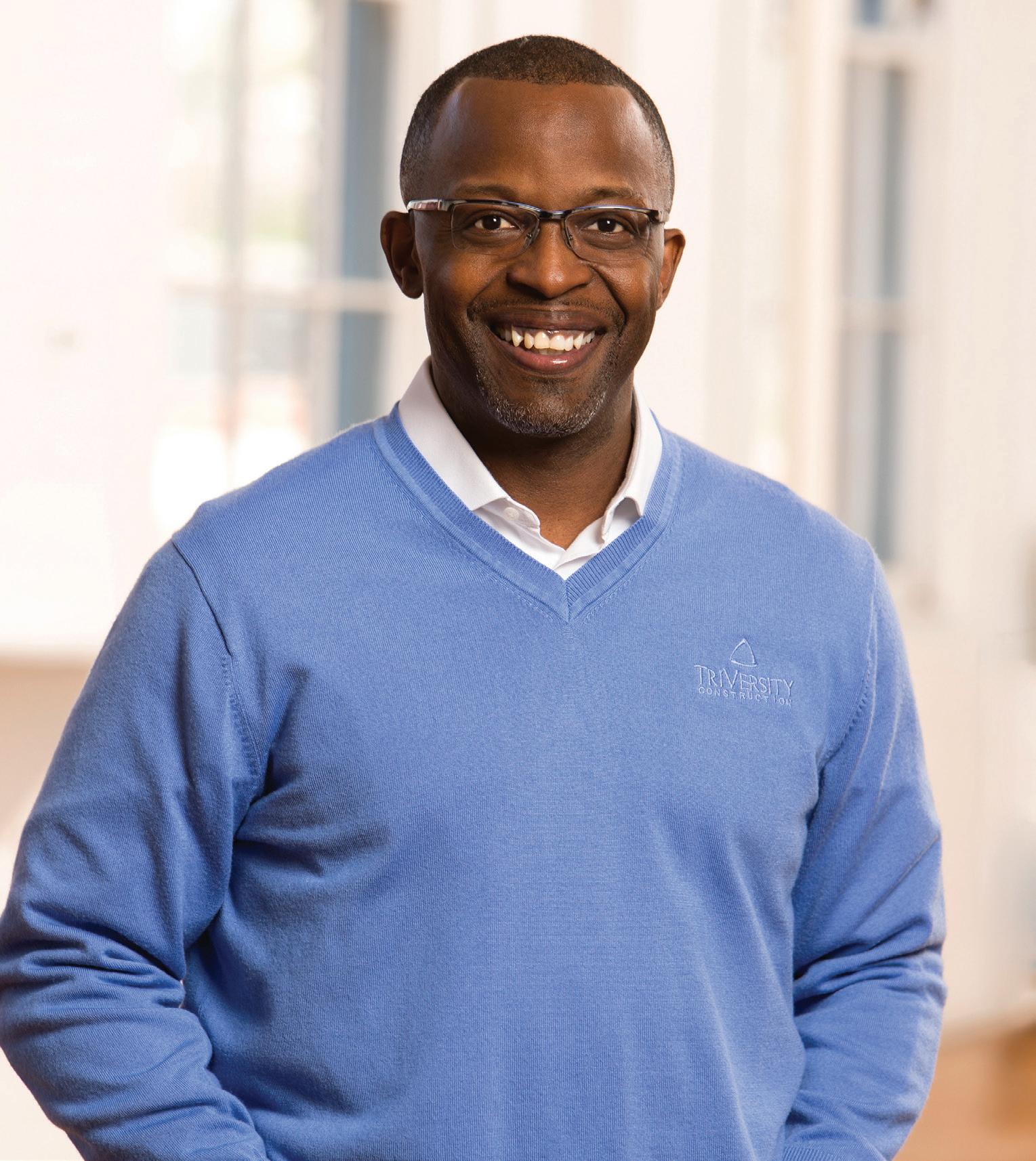
 BY ALEXANDRA FROST
BY ALEXANDRA FROST
Paul Miller, who owns Bircus Brewing Company in Ludlow, used to be a clown. Like a real, actual clown for the Ringling Brothers Circus. He dropped out of UC’s College-Conservatory of Music his senior year to run away and join the circus, living on a train and performing in 18 counties before retiring his red nose.
You wouldn’t think clowning around is the best preparation for a business career, but Miller has done alright with it. His Bircus venture is a combination of beers, food, entertainment, circus acts, and community, a passion project that carried on
his love for performing and spread it to his Northern Kentucky community. He purchased an old movie theater in Ludlow and held concerts and events and sold beer. He’d give performing acts creative freedom to put on their own mini-circus acts there, keeping his childhood dream and former career alive in his new business.
His small business represents the heart of Ludlow and is geared toward much more than beer lovers. Fami ly matinee shows and classes are held every weekend afternoon, and you can join a pickleball league or hang out on
Wednesday Vinyl night. City residents are finding community through beer, and much more. “Ludlow has a distillery across the street now (Second Sight Spirits), which is really cool, and you can’t make this stuff up— they used to build props for Cirque du Soleil,” Miller says. “We work together a lot. We did a circus folk festival, we had Talk Like a Pirate Day. It was so much fun.”
But it’s more than just a fun time with friends. Small businesses make up the heart of Ludlow, Miller says, and sup port “independent creatives” such as the local boutique, the ice cream parlor, and the tavern where the owner lives upstairs. “It’s a group of people who collaborate together,” he says. “It’s cool because we’ve got all this stuff going on, and it really hap pened organically.”
Just over the river in Walnut Hills, another brewery owner, Marvin Abrinica, takes an active role in supporting his community by hiring skilled labor at his Esoteric Brewing. He co-founded it the height of the pandemic in September 2020 and has worked purposefully to bring Walnut Hills residents into the business. “I want to lift up the neighborhood and put dollars in the pockets of people here,” he says.
Abrinica says “esoteric” refers to a lotus flower, a symbol of “fighting through adversity” and resilience because the exotic flower endures forces of nature to blossom. Walnut Hills itself has endured in similar ways, especially after Kroger closed
its grocery store there in 2017. On Fridays the brewery hosts a food drive alongside organizations like the Walnut Hills Food Collaborative, when underserved community members can pick up much-needed groceries.
“We believe that beer can change the world,” says Abrinica. “Our business is a reflection of who we are. If we can touch and improve the lives of the people around us in the neighborhood, we can be a rising tide for this community.”
Bircus and Esoteric Brewing, along with other small businesses across the region, have recently re ceived a boost to their community-focused efforts from “Storefronts to the Forefront,” an initiative of Duke Energy and the Cincinnati USA Regional Chamber. Amy Spill-

er, Duke’s president for Ohio and Kentucky, says the program evolved from a brainstorming conversation about ways Cincinnati’s corporate community could do more to help elevate the profile of the region’s unique neighborhood business districts.
“What we really wanted to do is address the ongoing challenges that small business owners were having through the pandemic and the eco nomic challenges that continued to plague all of us,” says Spiller. “So the purpose of this program is to highlight these unique, diverse business districts and give them access to all of the tools and development opportunities available through the Chamber.”
Spiller says she was inspired to partner on the program based on her own small-town upbringing. “I babysat for the owner of the phar-
WON’T YOU BE OUR NEIGHBOR? Small businesses in Milford (opposite page), Ludlow (above), and nine other neighborhood business districts are being boosted by Duke Energy and the Cincinnati USA Regional Chamber.
macy, and we knew the owner of the local newspaper,” she says. “There’s just such a true sense of community that’s enabled by vibrant small business districts. We have so many of those in our region, and they really are the heartbeat of the neighborhood, so we want to help support these vital assets.”
ASIDE FROM LUDLOW and Walnut Hills, business districts selected for Store fronts to the Forefront include Bellevue and Ft. Thomas in Northern Kentucky and East Price Hill, Loveland, Madisonville, Milford, New Richmond, Norwood, and Reading in Ohio. Each community participates in
virtual programs targeted to placemaking, business growth, and marketing and get exposure to business connections through the Chamber’s monthly e-newsletter, social media, and a video series produced by and airing on Fox19. Small businesses in each of the 11 communities receive Chamber membership access to advocacy, leadership development, cost saving programs, networking events, and more.
The initiative’s marketing support helps a business like BLOC Coffee Company continue making a differ ence in Price Hill. Café owner Dwight Young and his wife, Stephanie, have been working to improve living con ditions on the West Side for 25 years, launching the coffee shop in 2007 as

a safe and warm space for students to gather after school and adults to come together and have a conversation. Young says several businessmen who attend Holy Family Church on nearby West Eighth Street were concerned about prostitution and homelessness in the neighborhood and wanted to plant some positive roots.
“The coffee shop was the catalyst, honestly, to change this neighborhood,” says Young. “It really established a gathering place and started to function as a business and a welcoming place for people to come. Everybody from the mayor to the next-door neighbor was coming in for coffee.” The shop expanded three years ago, moving a few blocks from Price Avenue to the corner of Mt. Hope Road and West Eighth.
Young’s affiliated BLOC Ministries uses the coffee shop as a training ground and a recovery point for lo cal residents, especially women, who learn job training skills in the Redeemed Home program. The long-term intervention program is designed to serve women survivors of trafficking, prostitution and addiction, and participants can work or sell handmade goods at the shop.
Young says he and Stephanie are particularly focused on connecting immigrants with job opportunities. For example, one of BLOC’s chefs immigrated from Puerto Rico, and Young helped her get an apartment, a car, and a job. “She’s
unbelievable,” he says. “She’s a gifted woman we love, and she’s found a home here.”
The BLOC training programs are expanding further, says Young, and include getting students from five local high schools involved in culinary arts, sports training, and other vocations. “I can honestly say the stress we deal with these days is totally different than it was 25 years ago,” he says. “We’re interacting with the second and third generations of immigrant families now, and a lot of them are working and volunteering with us.”
The area around BLOC and Holy Family Church, known now as the Incline District, has developed into a bustling business district. Anchor businesses include the Warsaw Federal Incline Theater, the Incline Public House, and Veracruz Mexican Grill, along with the longtime “date night” restaurant favorite, Primavista.
Young says as many as 35 different buildings in the neighborhood, including his coffee shop, are used for BLOC Ministries and related initiatives. Remodeling that many buildings has also been a catalyst for change, he says, pointing out the number of newly painted and spruced up buildings on side streets. He’s happy to partner with community redevelopment organizations like Price Hill Will and with Duke and the Chamber in a further effort to support small businesses. “We don’t do ministry stuff on main commercial thoroughfares, because we want those buildings to rehabilitate back into what they were before, which was small businesses,” says Young. “We aren’t on main streets, because people won’t shop next door to that. You have to have both commercial and community support, but not necessarily on the same street.”
Abrinica agrees that small busi-
ness success and community support go hand in hand. “Walnut Hills is one of the most diverse areas in the city, not only from a racial makeup but also a socioeconomic makeup,” he says, pointing out that Esoteric’s CEO Brian Johnson is Cincinnati’s first Black brewery owner. “Small businesses have an important role to play in reviving broken communities.”
Support from Storefronts to the Forefront and the Cincinnati Minority Business Accelerator has helped the company expand job training and neighborhood programming, and the co-founders are scouting new locations for a business expan sion. Opening during the pandemic has come with a host of challenges, says Abrinica, but they’ve persevered.
STUART HELLEBUSCH prides himself on managing the oldest continually run bicycle shop in the U.S., Bishop’s Bicycles in Milford. The Bishop family founded the shop in 1890 in Winchester, Kentucky—it originally started as a gun shop a decade before that— and moved it to Norwood in 1910. The business eventually relocated to Milford in 1971. Hellebusch is the third owner since the Bishop family sold the business.

Carrying on a tradition that’s spanned generations brings depth and legacy to old Milford small businesses. “The vibe in Old Milford is fantastic,” says Hellebusch. “On weekends, streets are pretty full of people walk ing the sidewalks, checking everything out, and activity in all of the little shops. The
DORA (designated outdoor refreshment area) brings in a lot of traffic spanning the whole Milford area.”
Bishop’s Bicycles has a second location nearby, at the Little Miami Trail’s Milford Trailhead location, where bikers can rent a bike or grab a snack. Storefronts to the Forefront worked with Hellebusch to feature the company on a short video advertisement, hoping to increase traffic to the bike store that some mistake for a museum. “No, we’re a functioning bike shop,” he says, noting that in a nod to the company’s heritage you can check out some 100-year-old bikes hanging around the store.
Like many neighborhood retail shops, Hellebusch says he works constantly to convince consumers to head to Milford to purchase a toddler’s first balance bike or a $6,000
Business districts in East Price Hill (opposite page), Milford (below), and other neighborhoods depend on the holiday shopping season for a big percentage of the year’s revenue.
Eleven neighborhood business districts across the region are participating this year in “Storefronts to the Forefront,” an initiative of Duke Energy and the Cincinnati USA Regional Chamber to support small businesses still recovering from the pandemic.
Resurgent business districts in East Price Hill and Walnut Hills are hoping the additional marketing attention and networking available through the Storefronts program will attract new visitors and put money in the pockets of longtime neighborhood residents.
Creative, involved business owners provide districts in Ludlow and Milford and other established small towns with the kind of energy that generates collaboration and unites everyone.
competitive cyclist’s bike instead of ordering via Amazon or other online sites. “The internet isn’t going to build your bike,” he says. “The biggest difference we see is quality.”
Four or five mechanics work on bike repairs in the shop daily, says Hellebusch, and employees help accurately size for customers. “If the bike is too big, you have some safety issues,” he says. “If it’s too small, you’re not going to enjoy it.” Customized service and at tention to detail are the kinds of experience people find only in a neighborhood business district like Milford, he says, and he hopes his business will properly outfit local bikers for another century or more.
There’s a truism in the brewing industry, based on pandemic statistics from the Brewer’s Association, that Abrinica says reflects the challenges every small busi ness faces: For every brewery that opens, another closes. The State of Ohio’s 2021 Small Business Profile says that between March 2019 and March 2020 a total of 23,172 small businesses opened in the state, while 23,273 closed. That one-year timespan saw a loss of 3,556 jobs among small businesses. Almost half of the state’s workforce is employed by small businesses.
Promotional efforts such as Shop Local Saturday, scheduled this year for November 19, are essential re minders to consumers to support small businesses around the region and empower them to create and maintain vibrant communities for years to come. More than 80 percent of all U.S. businesses have fewer than 10 employees, and small businesses account for nearly half of the coun-
try’s total jobs. Holiday spending can often be a make-or-break event for small businesses. The U.S. Chamber of Commerce says that 70 percent of small business owners label the Thanksgiving/Hannukah/Christmas holiday season as important to their overall profit, with 37 percent saying it’s “very important.” An American
Express survey states that $0.67 of every $1 you spend at a small busi ness is reinvested right back into that local community.
The truth is that every day is a great day for supporting neighborhood business districts, and an easy way to start is to dedicate a weekend afternoon to wandering through any of the 11 Storefront to the Forefront’s featured communities. You never know which small business you might end up embracing for years to come, and you might fall in love with a neighborhood as much as its small business owners.
Watch videos featuring all 11 neighborhoods and find out how to better support small businesses at storefrontstotheforefront.com.
“THERE’S JUST SUCH A TRUE SENSE OF COMMUNITY THAT’S ENABLED BY VIBRANT SMALL BUSINESS DISTRICTS,” SAYS AMY SPILLER OF DUKE ENERGY.
“THEY REALLY ARE THE HEARTBEAT OF THE NEIGHBORHOOD.”
Products issued by The Ohio National Life Insurance Company and Ohio National Life Assurance Corporation. Guarantees are based on the claims-paying ability of the company. Products, product features and rider availability vary by state. Issuer/Issuers not licensed to conduct business in NY. Investment Advisory Services offered through O.N. Investment Management Company.

Financial Way | Cincinnati, OH 45242 | 513.794.6100 | ohionational.com
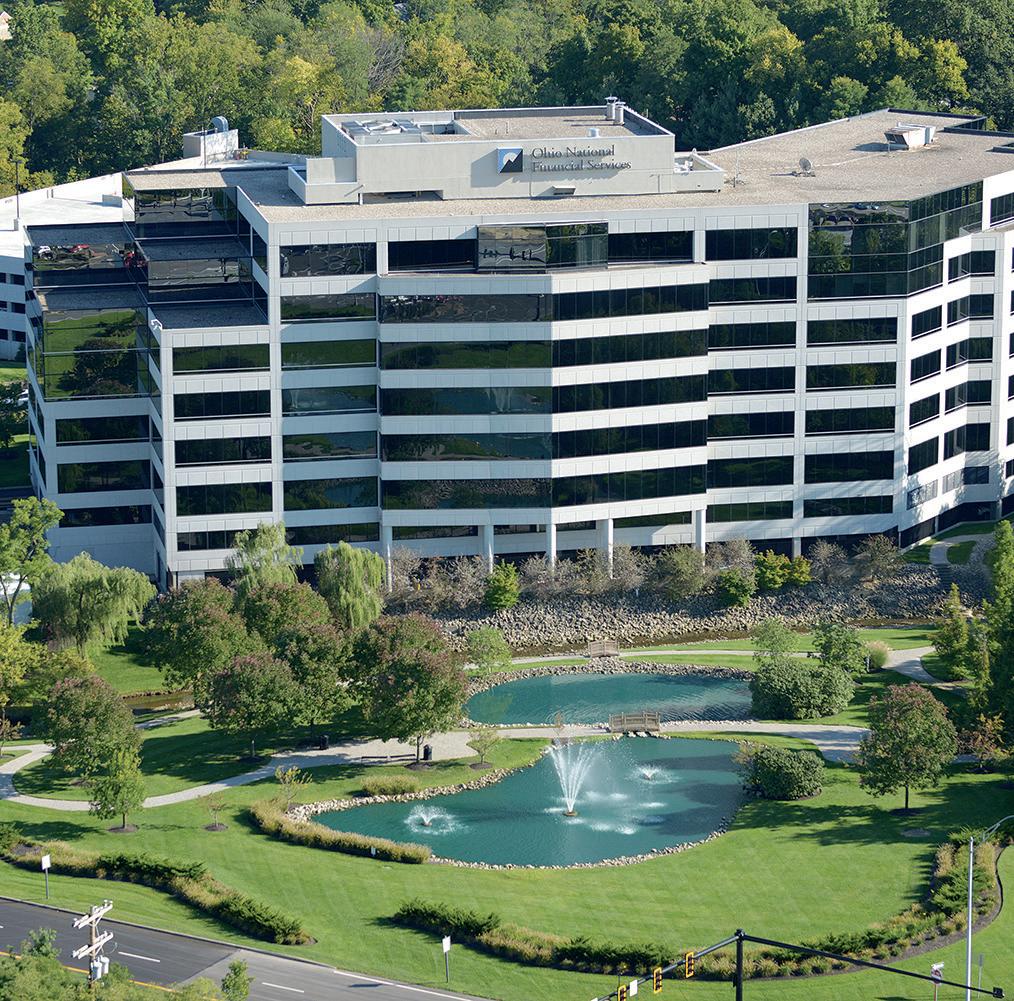






















Experience Savor: Chef’s Table, a fresh take on our classic dinner series. Be sure to #savorthedate with us and support our favorite local restaurants while enjoying a unique five-course dinner. Limited tickets available.









 Presented by
Presented by
New construction, new businesses, and a new attitude help revive the Madison & Whetsel business district.

–JOHN FOX
PHOTOGRAPHS BY ANDREW DOENCH
Declining neighborhood business districts don’t turn around overnight, nor does one person make it happen alone. But it does take dedicated residents and small business owners to restart a neighborhood’s momentum, which has been clear to see in Madisonville.
Brothers Austin and Tony Ferrari and mom Theresa opened the second location of their Mom and ‘Em Coffee & Wine (this page) in Madisonville earlier this year; their first is in Camp Washington. Food & Wine magazine named Mom and ‘Em the best coffee shop in Ohio. The Whetsel Avenue location is open 8 a.m.–3 p.m. daily and offers a Bistro Night dinner menu Fridays and Saturdays.


Madisonville is one of 11 neighborhood business districts supported by “Storefronts to the Forefront,” a marketing and economic development program funded by Duke Energy and the Cincinnati USA Regional Chamber. See more about the program on page 46.

Sheryl and John Vojtush purchased Bad Tom Smith Brewing (this page) in 2015 and moved it to Madisonville in November 2019. The business name honors an Eastern Kentucky outlaw from the late 1800s who was hanged for his crimes and famously said at the end, “Bad whiskey and bad women have brought me where I am.”




Head Brewer Sean Smith manages the company’s 20-barrel brewing system, along with a second system for small batch brews, which are in Batavia. The taproom has 18 craft taps and serves Bad Tom Smith Breathitt County & Cheating the Gallows Straight Bourbon, along with a line of craft cocktails. Located in an old bank building, the space can seat more than 100 guests.

Cincinnati native Shawnte Barker (above) is a graduate of UC’s College of Design, Architecture, Art and Planning who opened Stylish LeNese Boutique on Whetsel Avenue in 2019, just before the pandemic kicked in. She moved back to Cincinnati after spending 15 years designing for major fashion retailers such as New York & Co. and Macy’s in New York City.


The boutique sells curated and classically designed clothing and accessories for women and girls ranging in sizes from Small to 3X and junior sizes from 12 months to 9/10. It also offers upcycled and reworked stylist services and customizable T-shirt designs, as well as tailoring and alterations for apparel and home goods. Barker also hosts “sip and shop” and seasonal fashion show events.

 PHOTO
PHOTO
Reserve your stay at the new Delta Hotels Marriott Cincinnati, centrally located right off the intersection of I-275 & I-75. Just 15 minutes north of downtown Cincinnati.


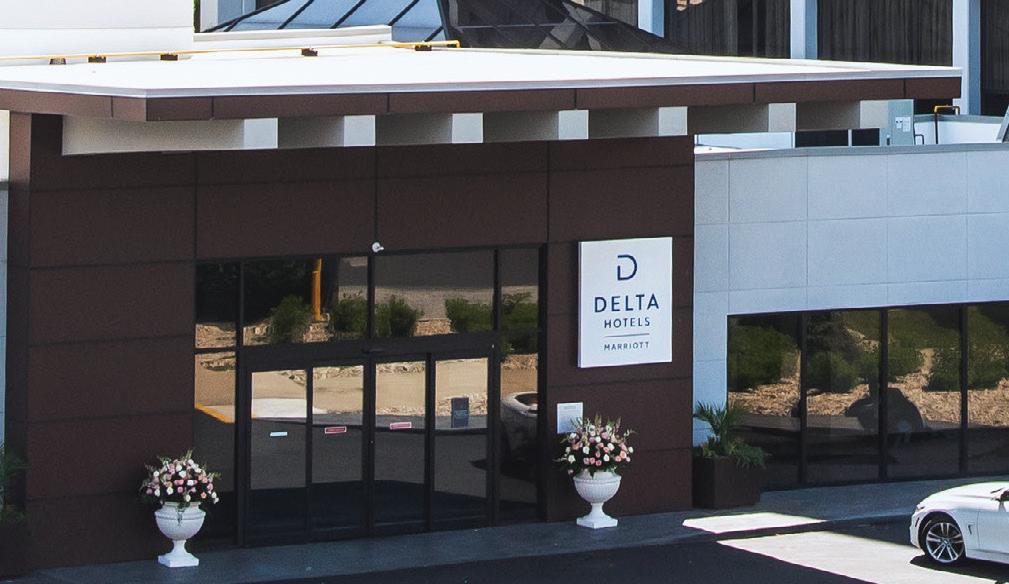
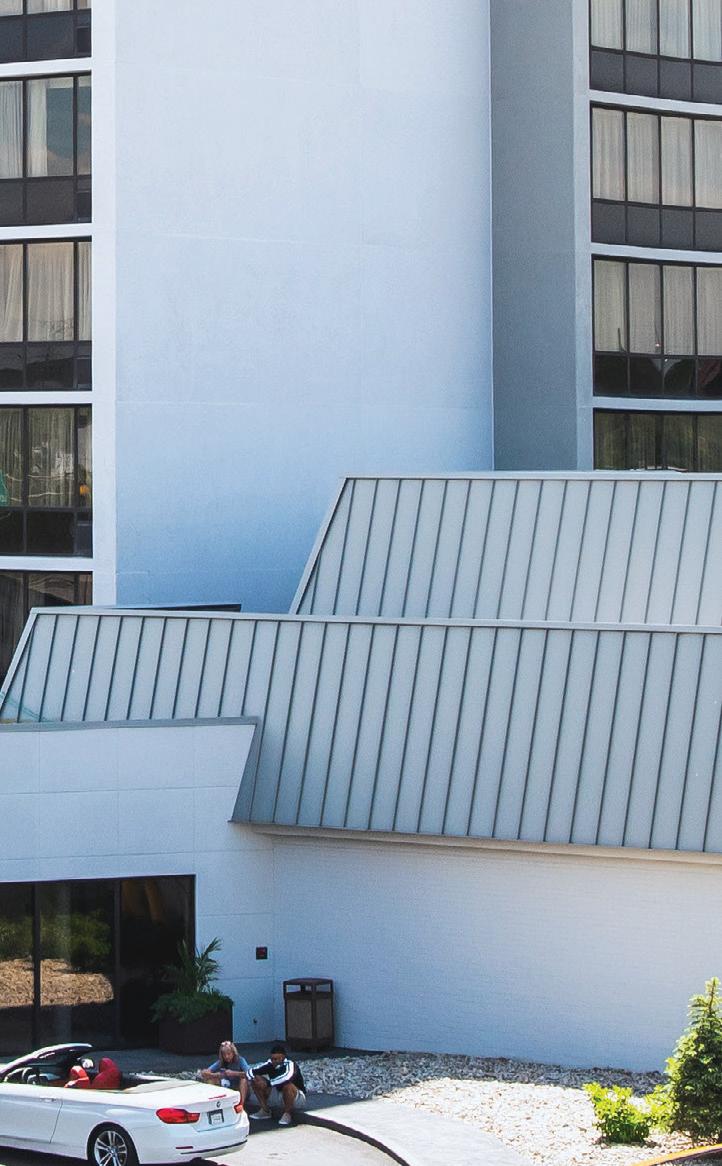






Host conferences in one of our many event rooms with 20,000 square feet of event space configurable to your needs.
www.marriott.com/cvgde nidhi@deltahotelscincinnati.com
Gabrielle Lauren’s interest in cutting out excess waste in her own life grew into a full-fledged community initiative and eventually, in late 2020, into a Madisonville storefront called Fill More Waste Less (this page). She says that zero waste is a lifestyle and a mindset around reducing the amount of trash we all produce on a daily basis. She likes to live by the five R’s: reduce the amount of things you need, reuse what you can, recycle responsibly, refuse things you don’t need, and rot-compost what you can.


Fill More Waste Less is designed to help customers start their zero waste journey, knowing that it’s a process and not something you perfect overnight. The store offers a selection of refill options (from body lotion to laundry detergent) and zero waste essentials (from dish towels and bamboo utensils to glass straws and recycled crayons). It’s open Wednesday through Sunday and by appointment on Tuesday.






ASK ME ABOUT Making live horseracing relevant for a new generation through a $148-million renovation.
ASK ME ABOUT Why kindergarten readiness is such an important topic.
PRESIDENT CINCINNATI PRESCHOOL PROMISEHOW DOES A QUALITY PRESCHOOL EDUCATION IMPACT A STUDENT’S EDUCATIONAL TRAJECTORY? Research has shown that how prepared children are when they first enter school is a strong predictor of success in future grades. Preschool provides the foundation for kindergarten readiness and supports children’s social, emotional, phys-
ical, cognitive, and linguistic development.
WHAT TOOLS DOES CINCINNATI PRESCHOOL PROMISE PROVIDE IN CREATING HIGH-QUALITY, ACCESSIBLE PRESCHOOL OPPORTUNITIES? Since 2017, we’ve provided tuition assistance to more than 7,900 children. We build partnerships with community preschool providers
to increase the number of high-quality programs, particularly in neighborhoods with a quality gap. By offering coaching, professional development sessions, and educational materials, we’ve helped more than 210 preschool sites reach a rating of three or more stars on Ohio’s Step Up to Quality rating system.
We help sustain high-quality programming by supporting recruitment, retention, and wage parity for educators.
HOW DOES THIS SUPPORT THE FUTURE OF A COMMUNITY AT LARGE? Year after year, more than 85 percent of families have stated they wouldn’t have been able to fully afford preschool without our
support. Cincinnati Preschool Promise has also prioritized strengthening the early childhood education talent pipeline through strategic partnerships in the community. –ELIZABETH MILLER WOOD

YOU’RE THE IMMEDIATE PAST PRESIDENT OF THE CINCINNATI BAR ASSOCIATION, WHICH JUST CELEBRATED ITS 150TH ANNIVERSARY. HOW DOES THE CBA SUPPORT THE REGION’S LEGAL COMMUNITY? The CBA has remained a hub for education, collegiality, and professionalism for Cincinnati’s legal community. We help their professional practice, which helps the community. The CBA also helps the community through our Lawyer Referral Service. During election cycles, we provide judicial forums and publish judicial candidate reviews.
WHAT INTERNAL OPPORTUNITIES DOES THE CBA PROVIDE? We work hard to provide access to information and networking that attorneys can’t find anywhere else. We host a wide variety of continuing legal education (CLE) opportunities. Anyone from first-year law students to federal judges can
PHOTOGRAPH COURTESY CHARA FISHER JACKSONattend any of our events. We also offer opportunities for career-building, from publication in our bimonthly legal magazine The Report to hosting CLE events to expanding skill sets with our Cincinnati Academy of Leadership for Lawyers.
WHAT ROLE HAS THE CBA PLAYED IN THE CITY’S HISTORICAL LANDSCAPE? Several Cincinnati mayors have been CBA members. In the 50 or so years after the CBA formed in 1872, the legal community had a direct influence on city development, politics, and decision-making. Today’s CBA members are leaders in all areas of our community, from school boards and nonprofits to businesses and elected offices.
HOW WILL THE NEW TURFWAY PARK EXPERIENCE BE IMPROVED? Turfway Park has such a rich legacy in Kentucky, and our goal has always been to restore it to its former glory. In addition to the exceptional live racing that fans have come to expect, Turfway will be anchored by Northern Kentucky’s largest historical racing machine facility, making it a state-of-the-art entertainment destination year-round.
ASK ME ABOUT The Cincinnati Bar Association’s role in supporting the region’s legal community.


WHAT’S BEEN ADDED TO ATTRACT A NEW GENERATION OF RACING FANS ? We replaced Turfway’s previous Polytrack with a new $5.6-million Tapeta synthetic track. The final phase includes a new event center, a gaming entertainment floor with 850 historical racing machines, a modern clubhouse, a simulcast wagering area with VIP player amenities, several food and beverage
venues, and an upscale sports bar.
WHY IS IT IMPORTANT TO UPHOLD THE TRADITION OF HORSERACING AT TURFWAY? This project will revitalize the Kentucky winter thoroughbred racing circuit while improving the health of the state’s entire signature horse industry. The result will be a first-class racing product fueled by increased purses that keep high-qual-
ity horses in Kentucky yearround while appealing to horseplayers nationwide. This kind of investment protects thousands of jobs throughout the state and creates significant tourism impact.
PHOTOGRAPHS COURTESY MICHAEL TAYLOR SARA COOPERRIDER –E.M.W.Christie Kuhns, named president and CEO of the Urban League of Southwestern Ohio in June after serving in an interim role, is overseeing a strategic planning process that will refine its community programs and upgrade staff compensation and benefits to “best in class.” The result, she says, will be improved services and more grants to promote economic self-sufficiency in underserved communities.

1 Kuhns says this doll, a gift from local activist Iris Roley, reminds her that she and the Urban League must always be accountable to the community.
2 Kuhns served one term in the Ohio House of Representatives and received this proclamation celebrating her Cincinnati NAACP President’s Award.
3 Family photos, especially of her son and daughter, reinforce why her work is important. “We have to leave the world better than we found it,” she says.
4 Kuhns helped open a health center in Avondale after volunteering with the neighborhood council and then leading UC Health’s planning work.


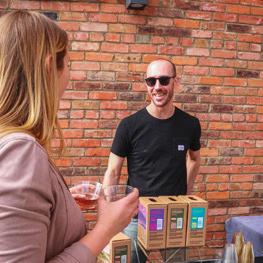
In 2017, Cintrifuse created StartupCincy Week to bring together a diverse set of partners with unique strengths and areas of expertise, resulting in a vibrant and energetic community. Today, Cintrifuse acts as a cornerstone to the Greater Cincinnati ecosystem, helping to inspire ideas, empower founders, and attract investors to make our region a magnet for entrepreneurs and innovators worldwide.
In 2021 our region expanded to 300+ startups that raised over $671 million in total funding and over 85 vetted resources. Additionally, we offer hundreds of hours of programming a year, including StartupCincy Week, which is back in person for the first time since 2019.



After years of quiet due to the COVID-19 pandemic, the ecosystem is bursting with energy and excitement about our shared future. This year’s StartupCincy Week will harness that energy and use it to spark a burst of innovation all across Cincinnati. Cintrifuse is thrilled to host this week-long event, where more than 1000 startups and ecosystem members have the opportunity to engage with our region’s top minds during workshops, panels, and curated networking events.
StartupCincy Week is made possible by the incredible ecosystem collaboration of our key partners: Alloy Development Co., Blue North, CincyTech, ECDI, Endeavor, Flywheel Social Enterprise Hub, Product Refinery, REDI Cincinnati, and Reversed Out Creative. These organizations’ time, dedication, and energy are bringing Cincinnati a vibrant week of programming grounded in community and ongoing partnership.

We’ve got this, Cincinnati. We’ve got the collective power of our business community, which can help our economy bounce back from the challenging last few years and emerge stronger.
We continue to work closely with REDI Cincinnati to attract new businesses to our region.
We remain committed to delivering clean, reliable and affordable energy to area businesses.



We lead by example and continue to pursue a strategy that integrates diversity and inclusion. And we’ve launched an initiative with the Greater Cincinnati USA Regional Chamber called Storefronts to the Forefronts.




Please join us in taking action to spark our local economy. Something as simple as visiting one of our region’s small business neighborhoods can have a lasting impact on our local economy and our region.
Learn more and get involved at: duke-energy.com
the energy of all of us.